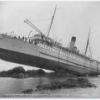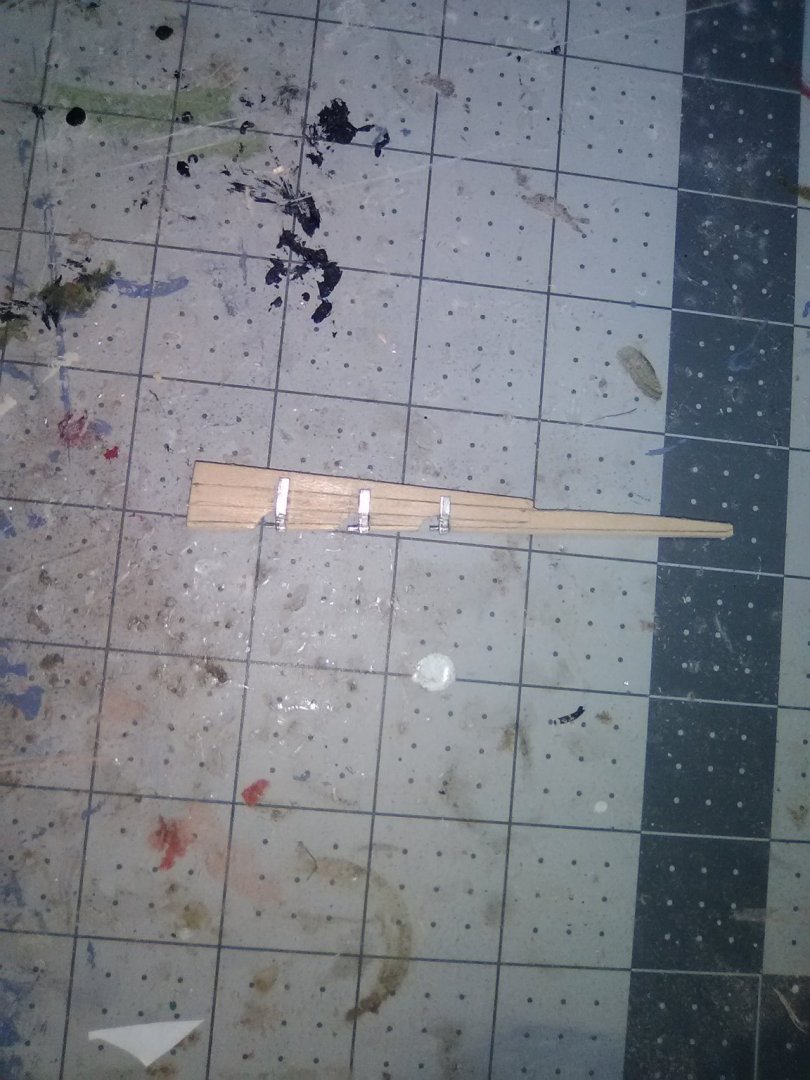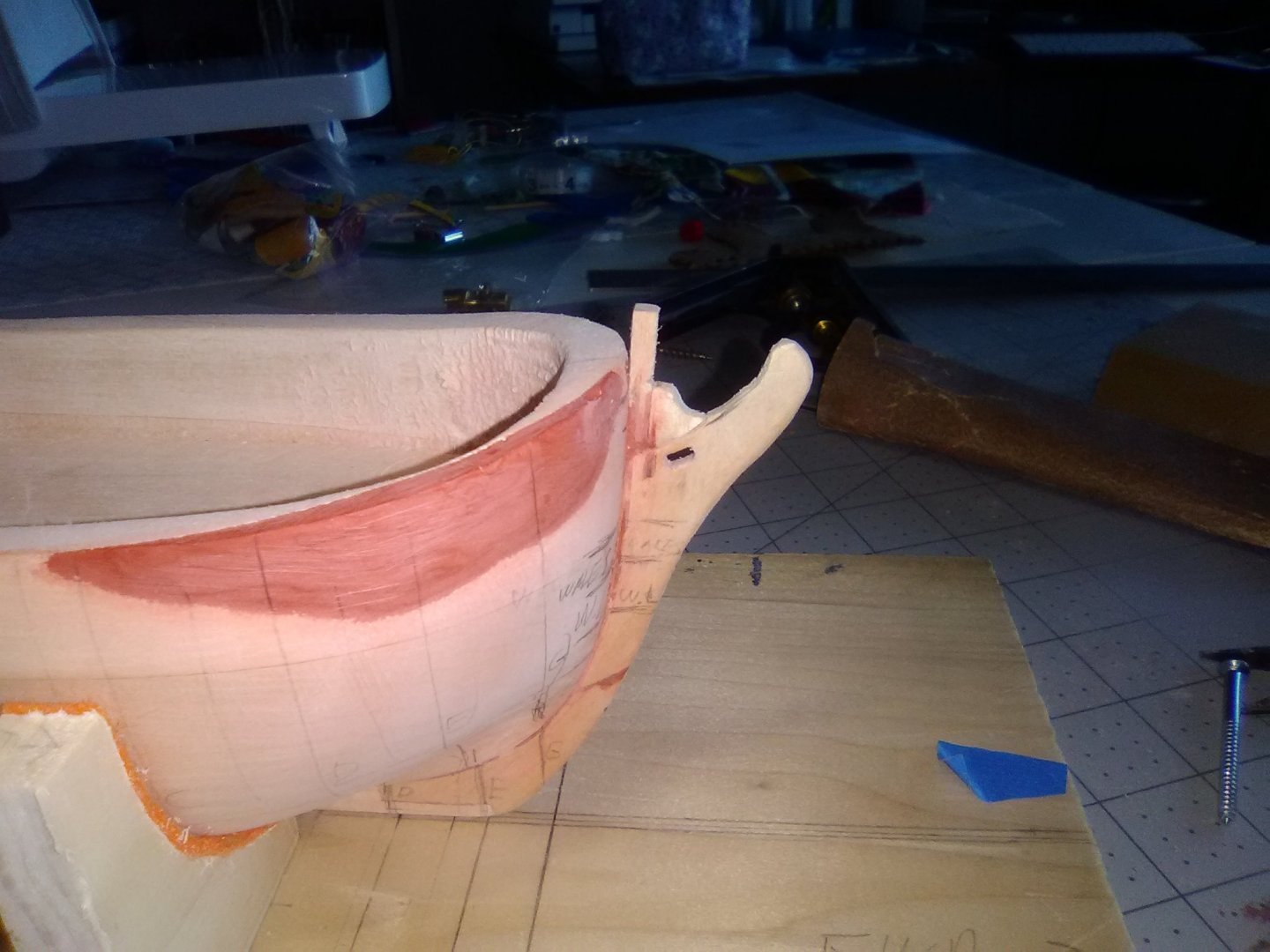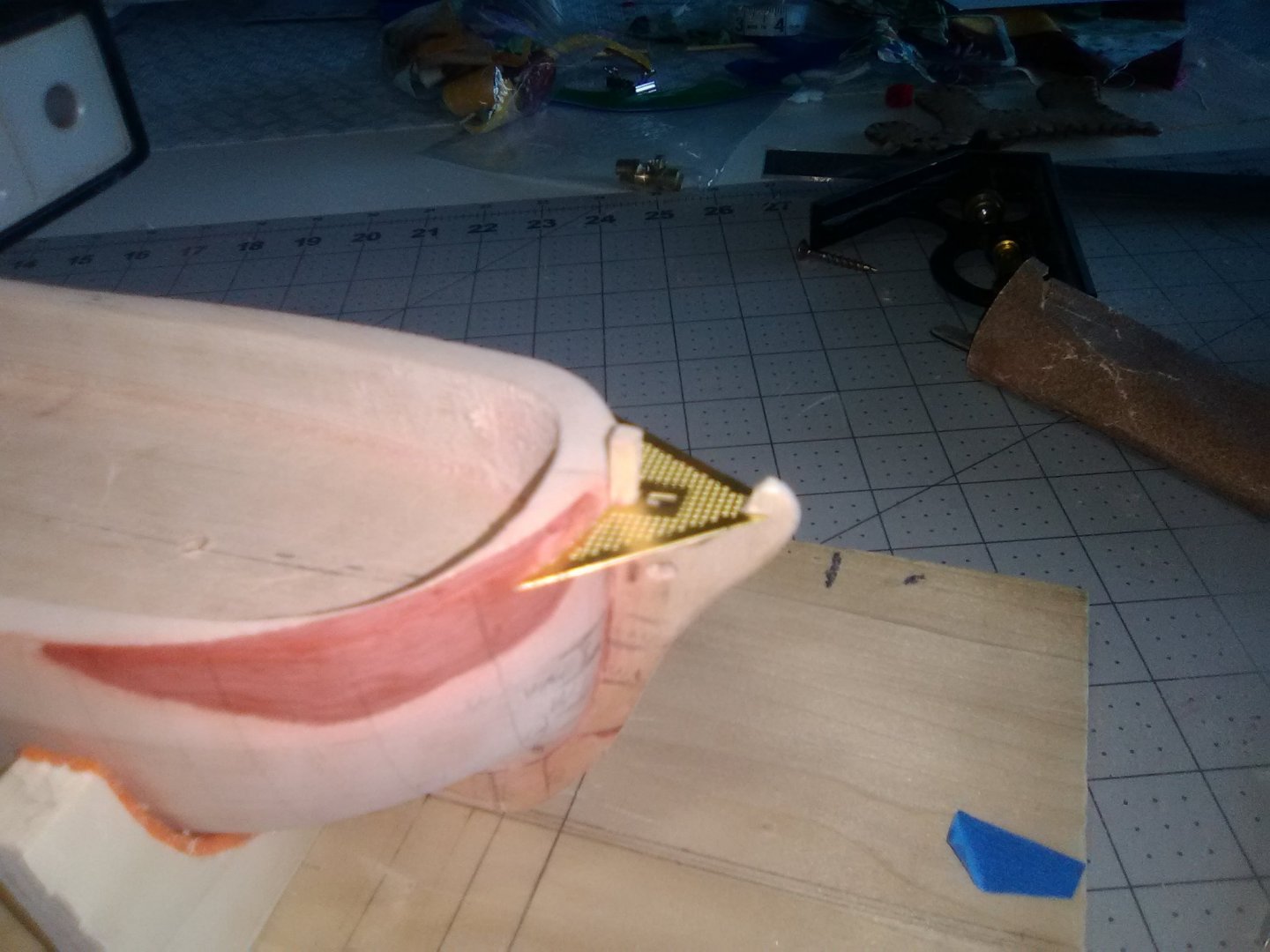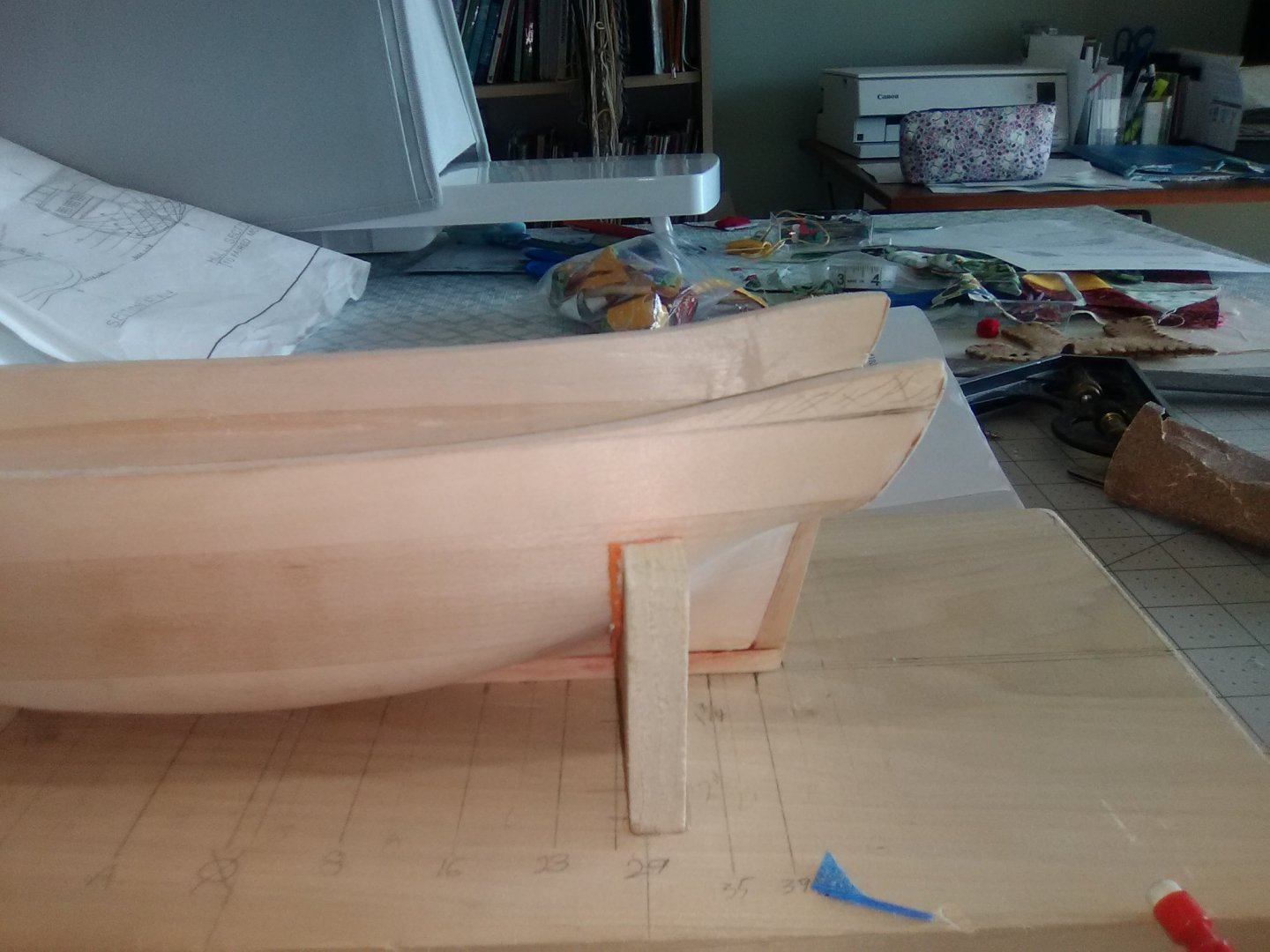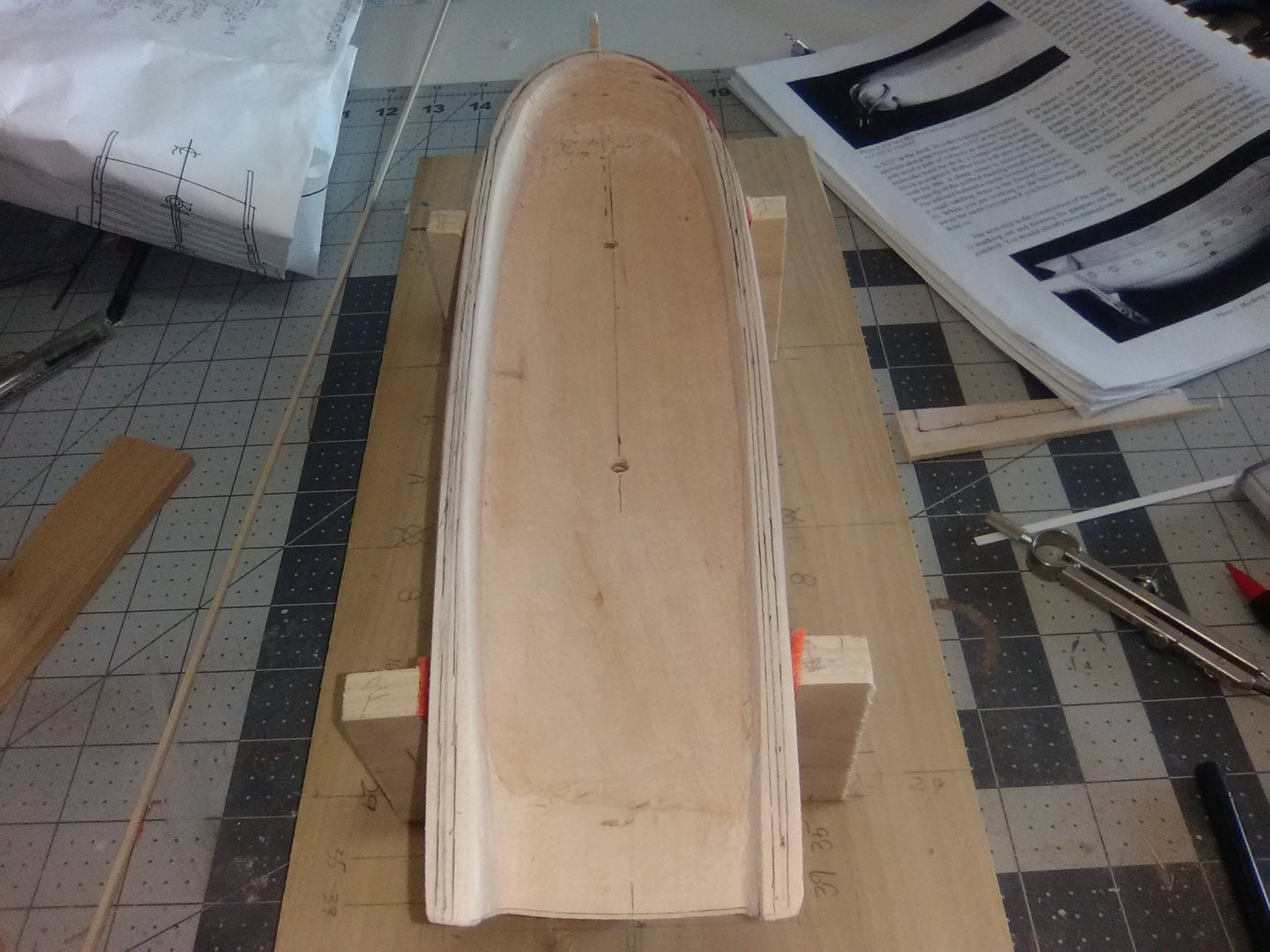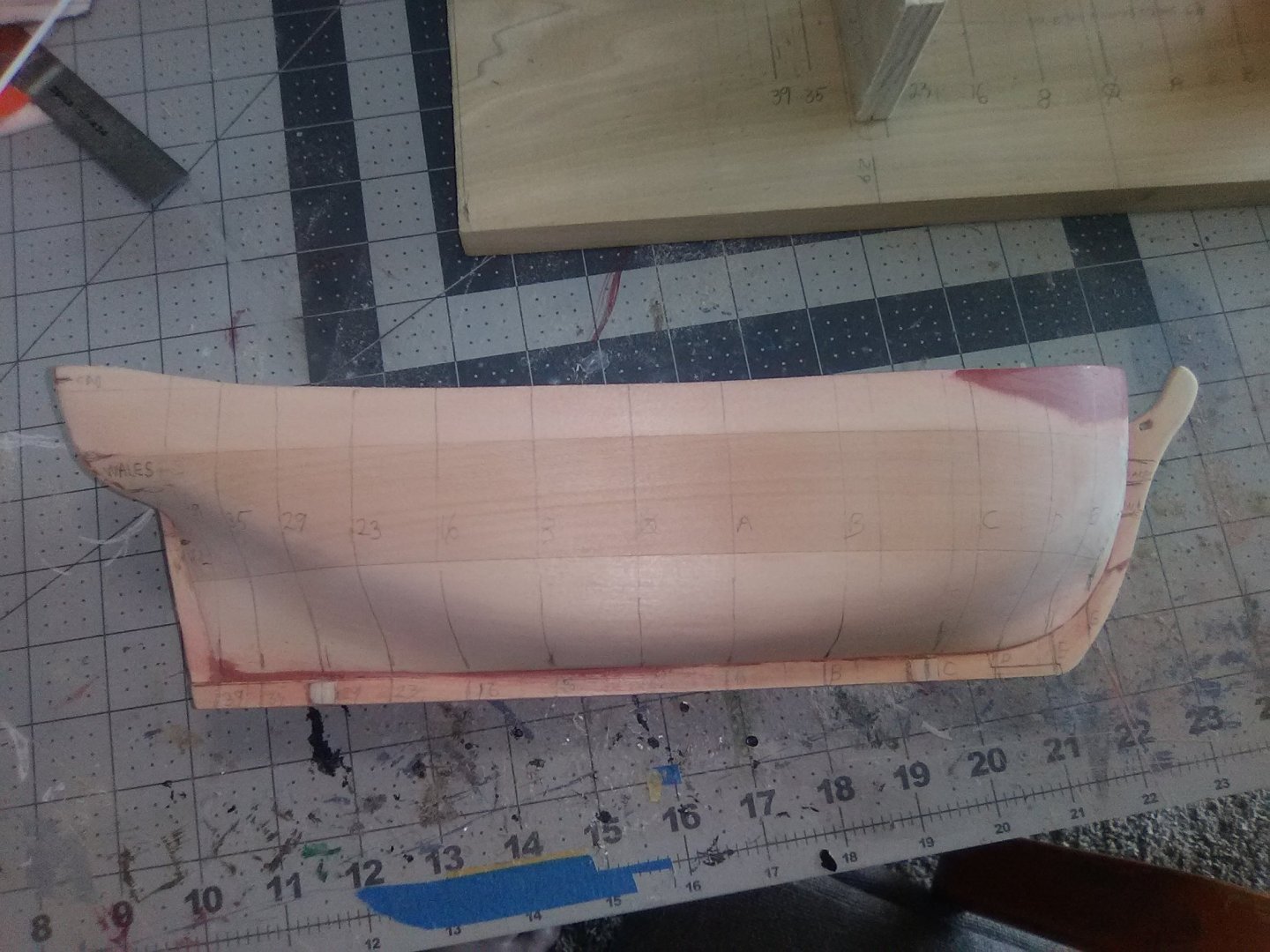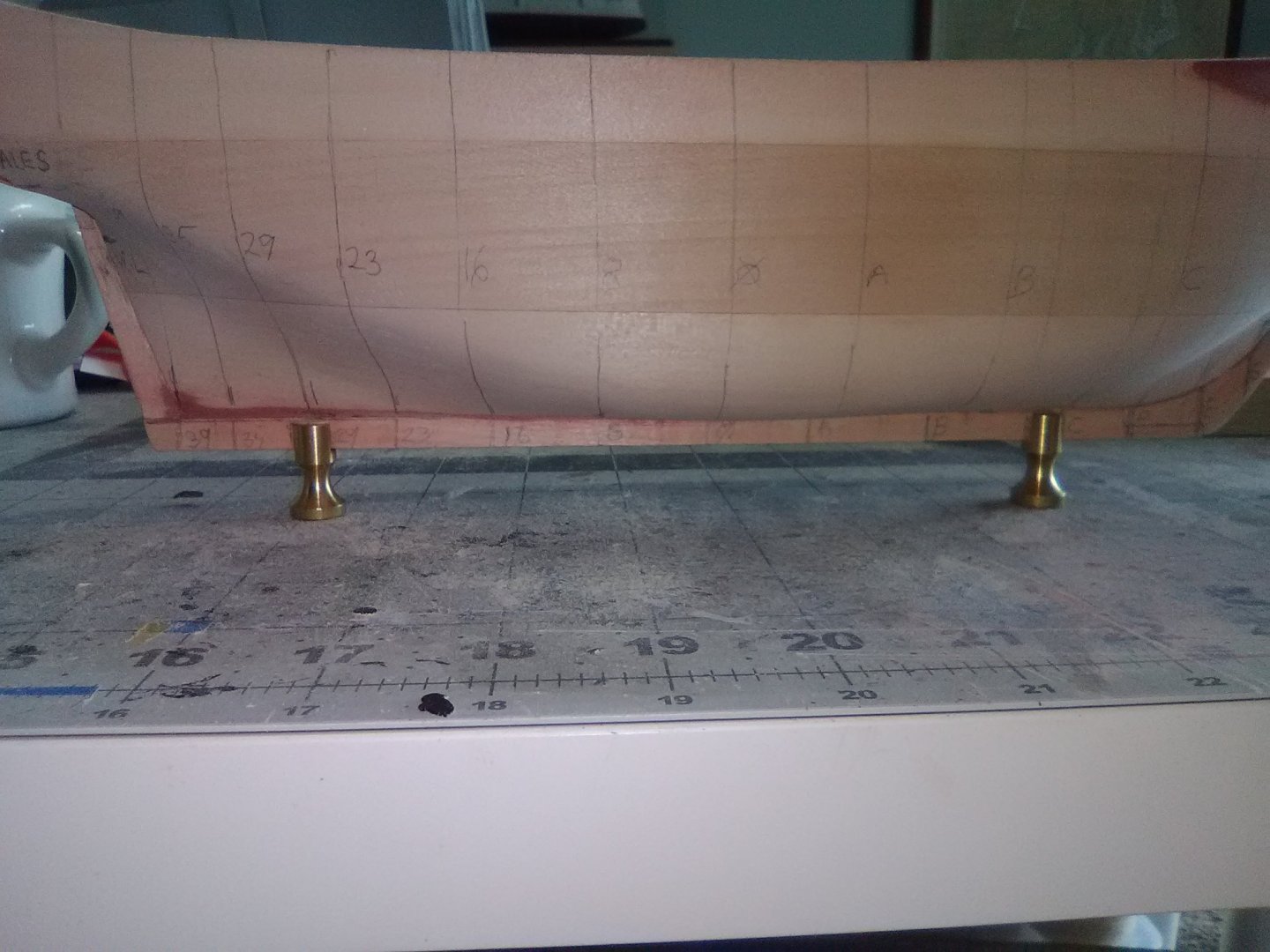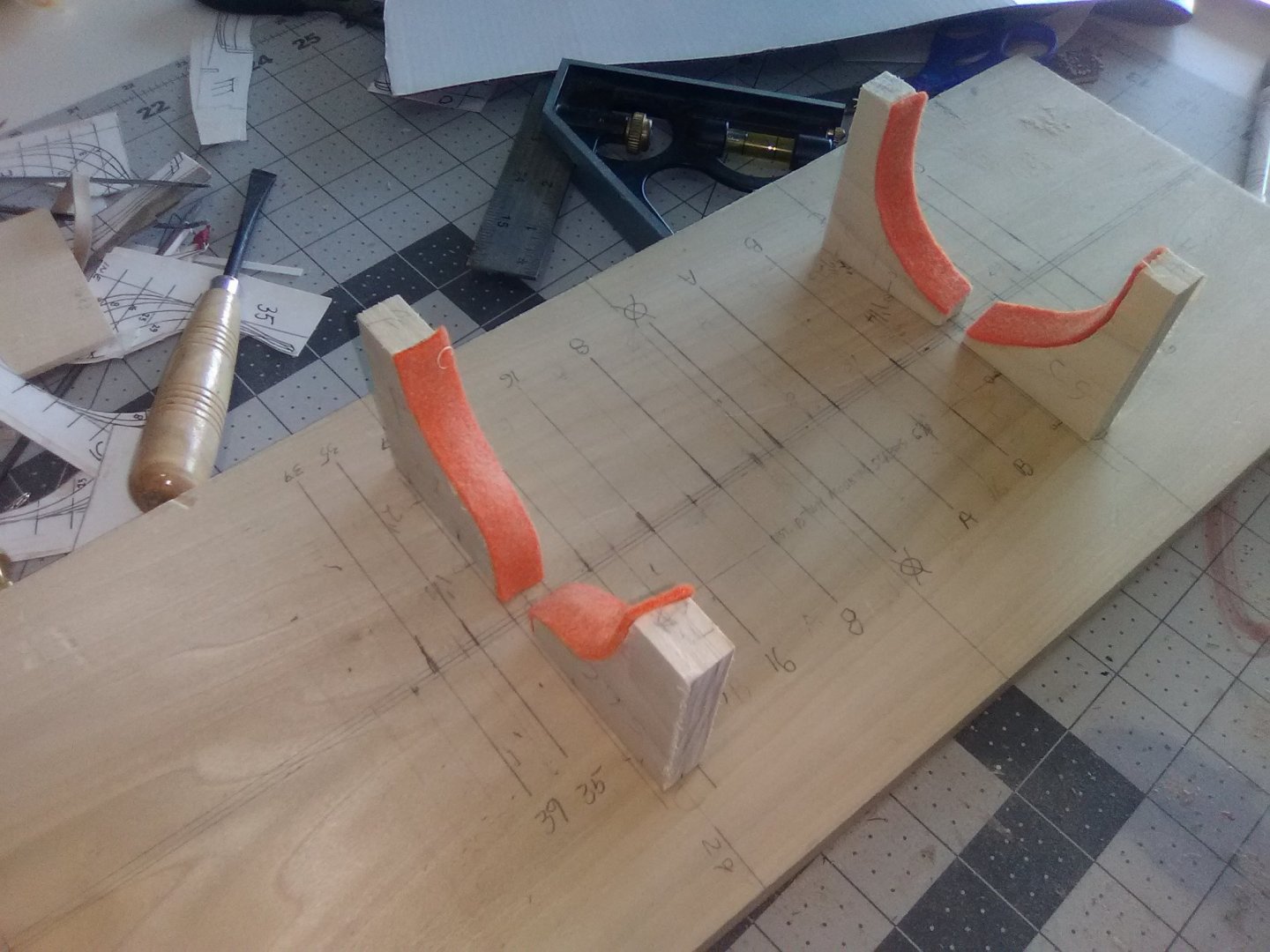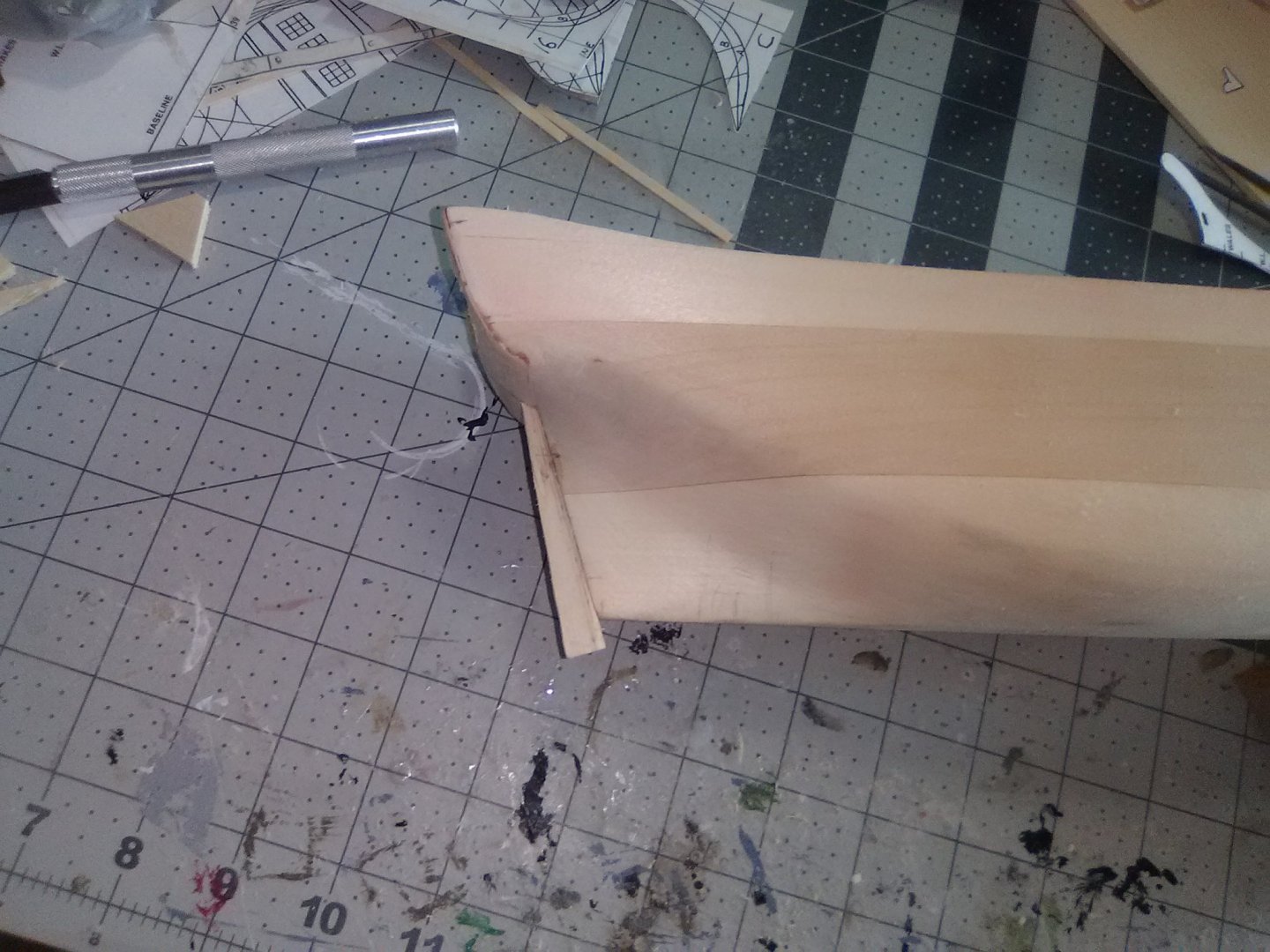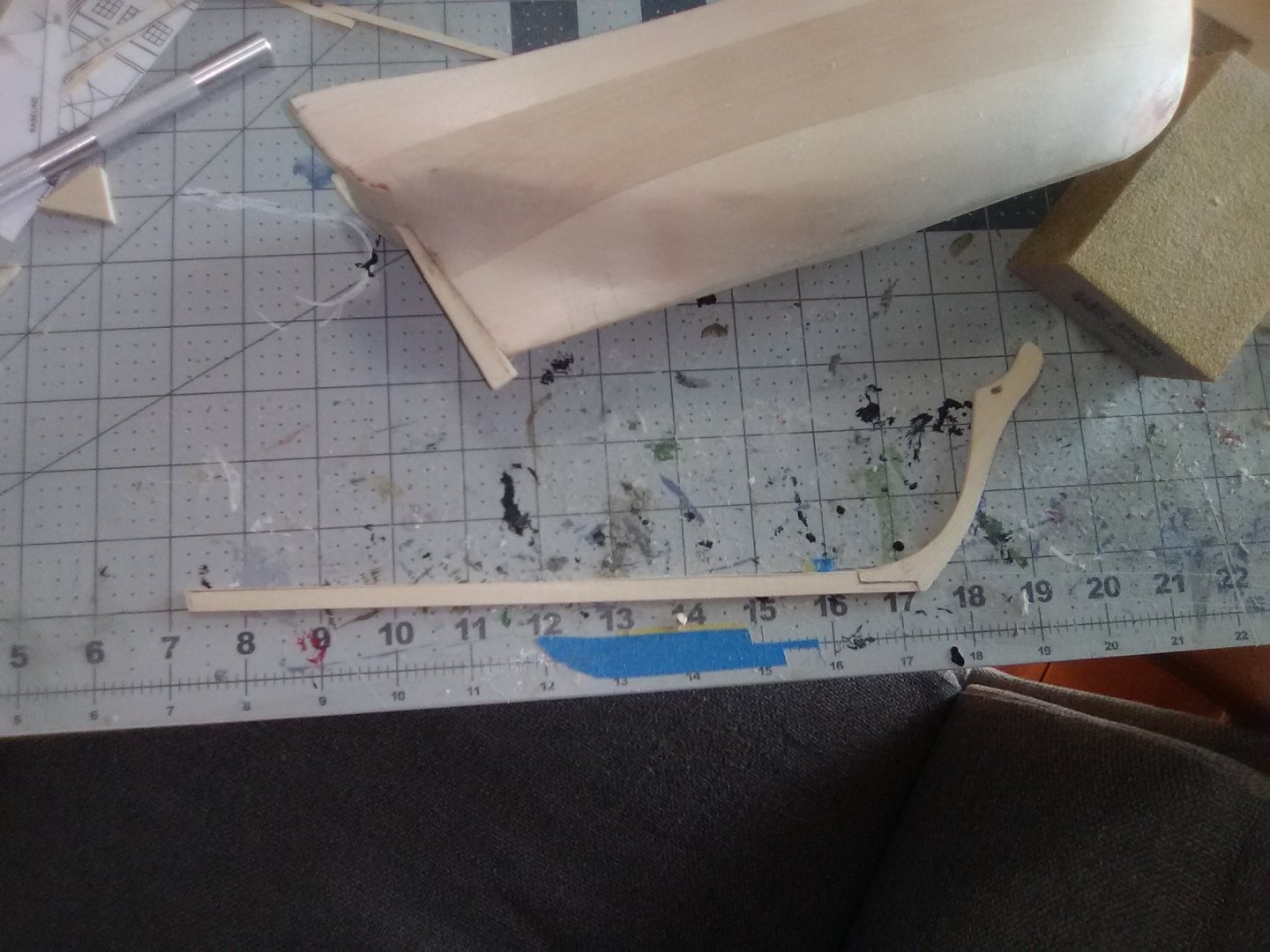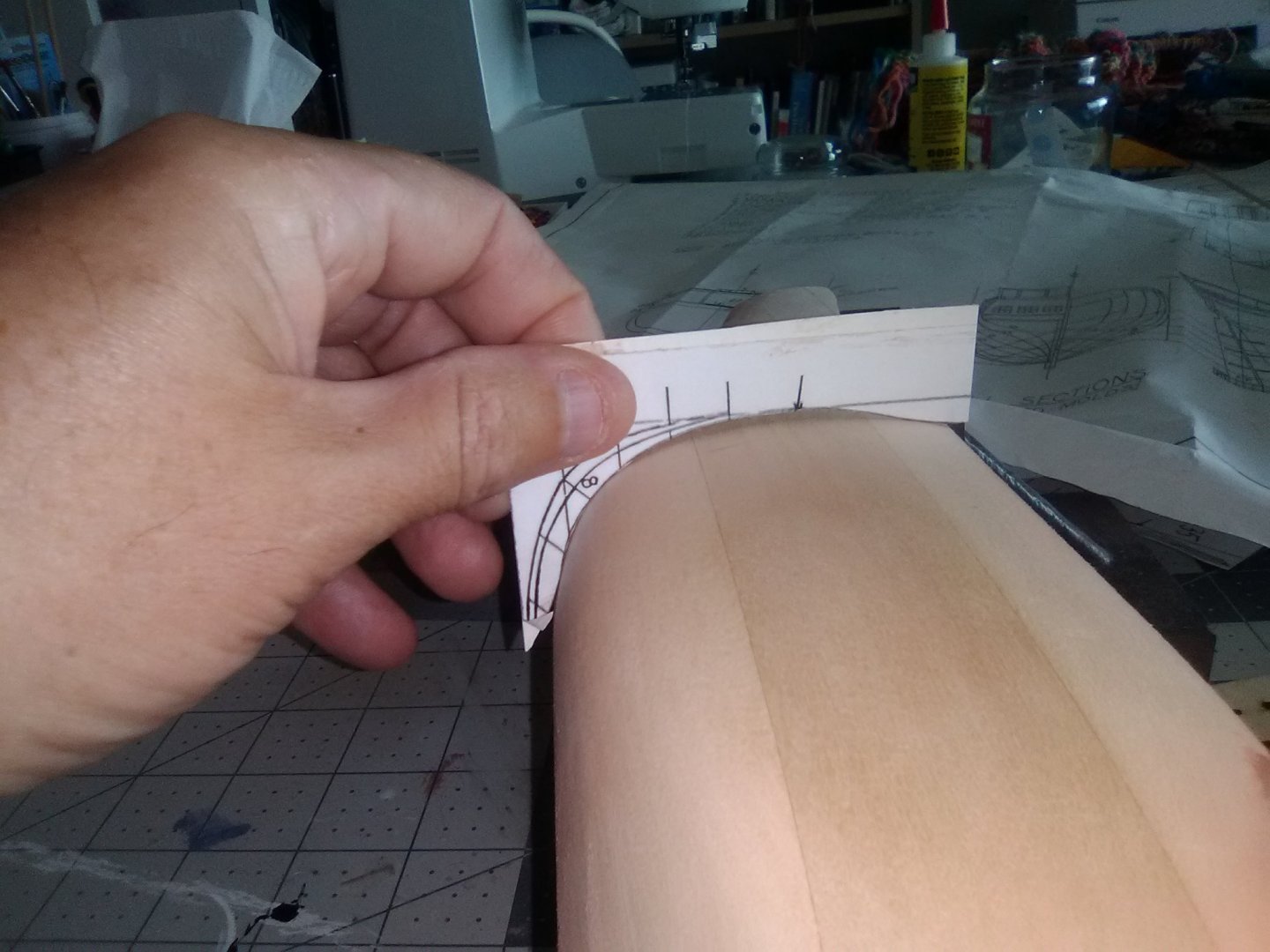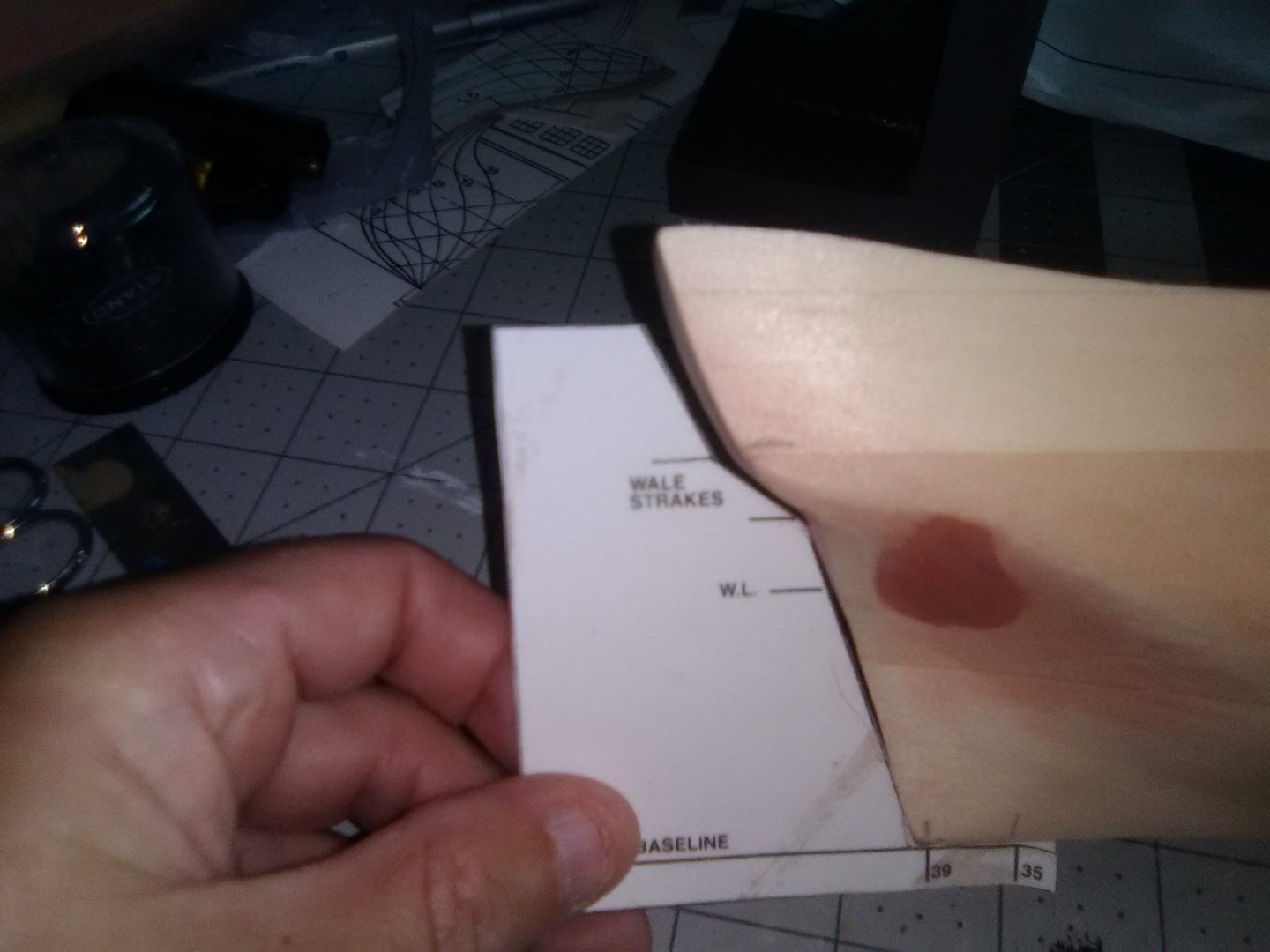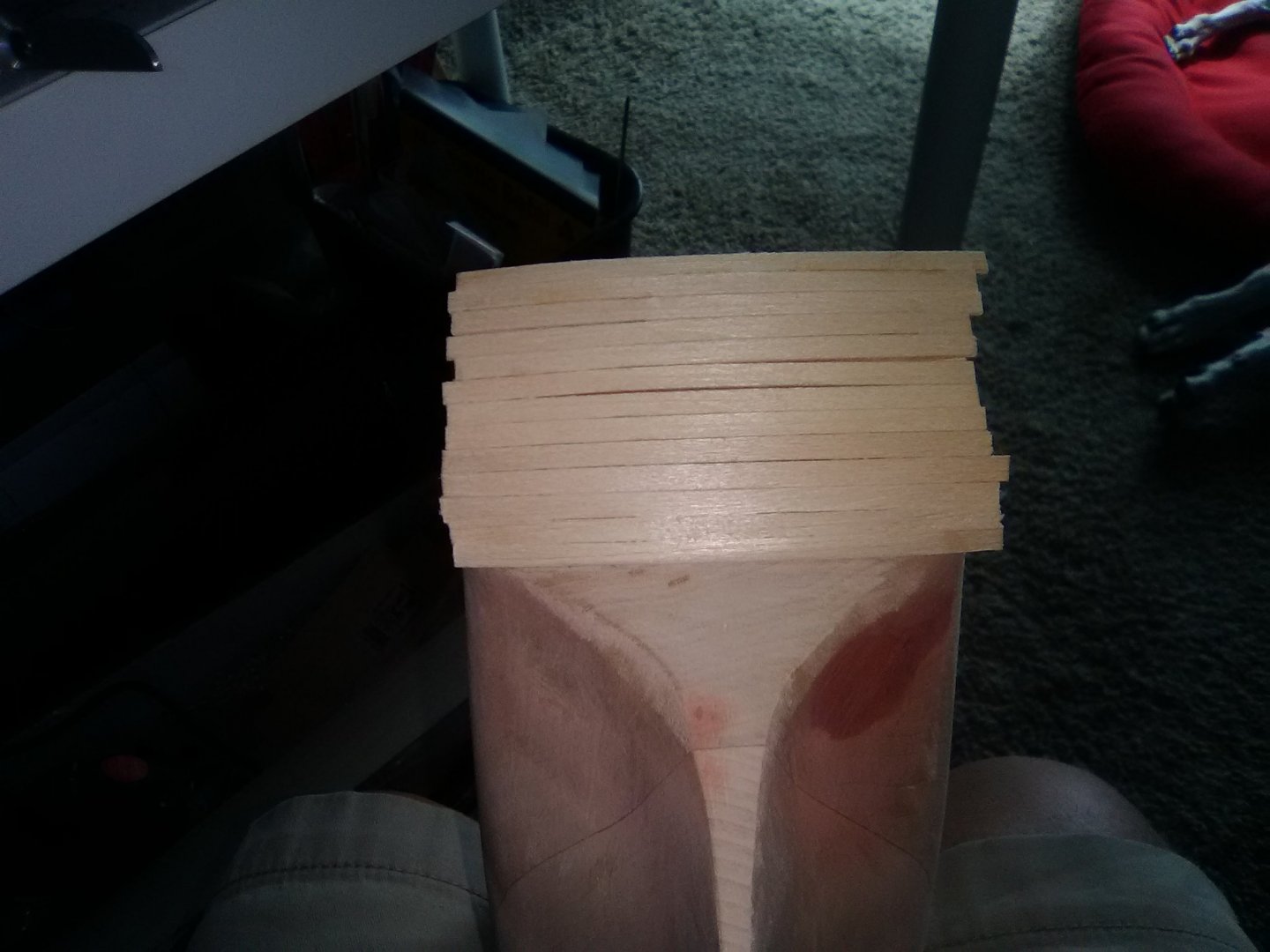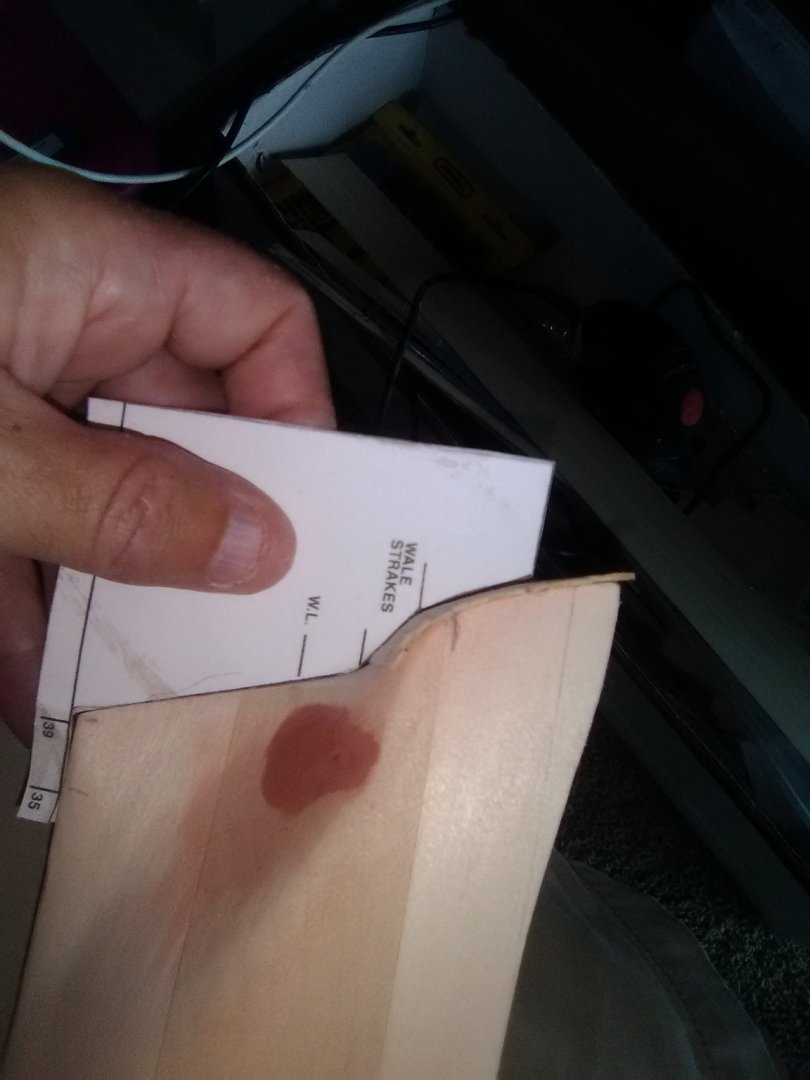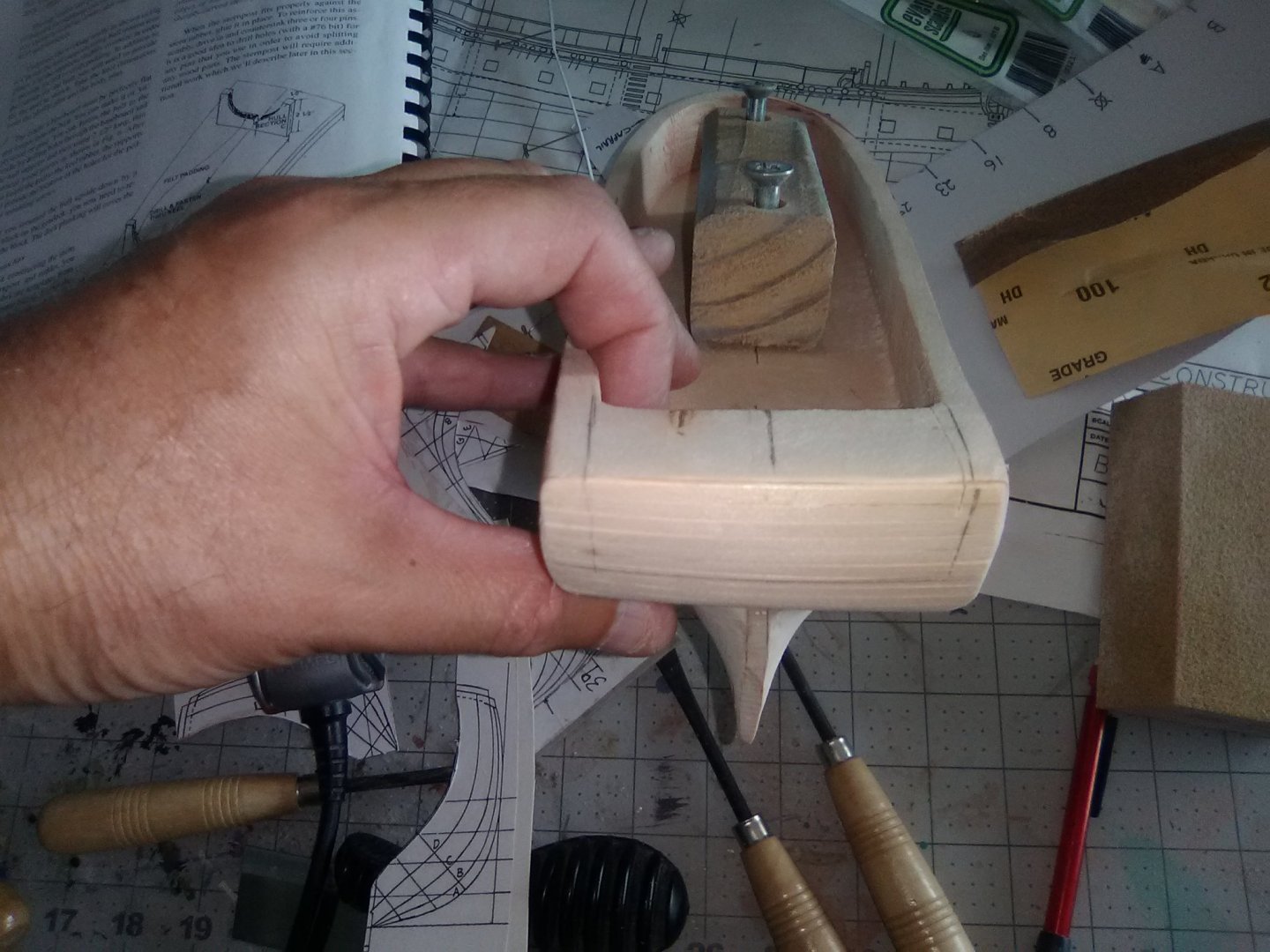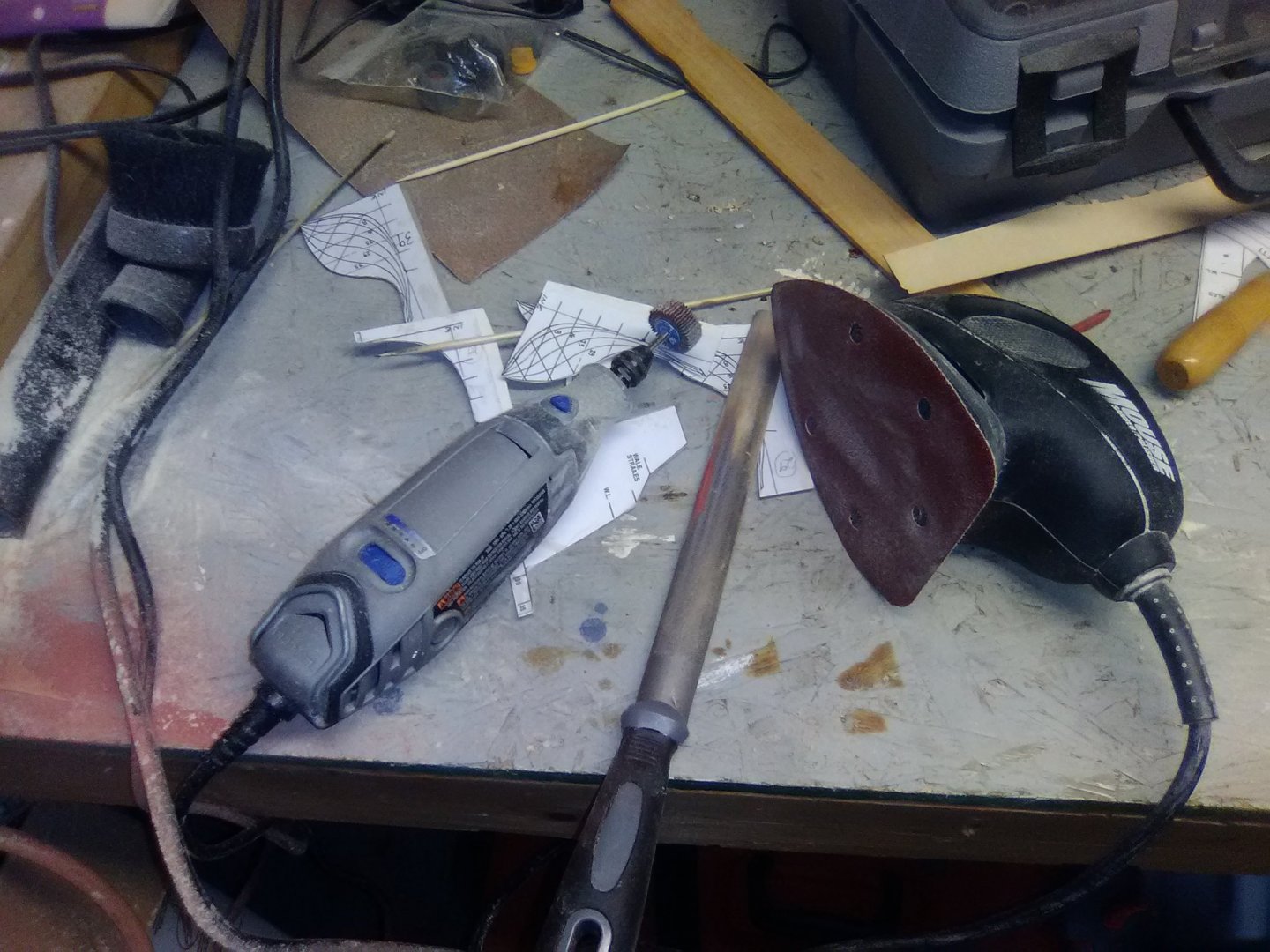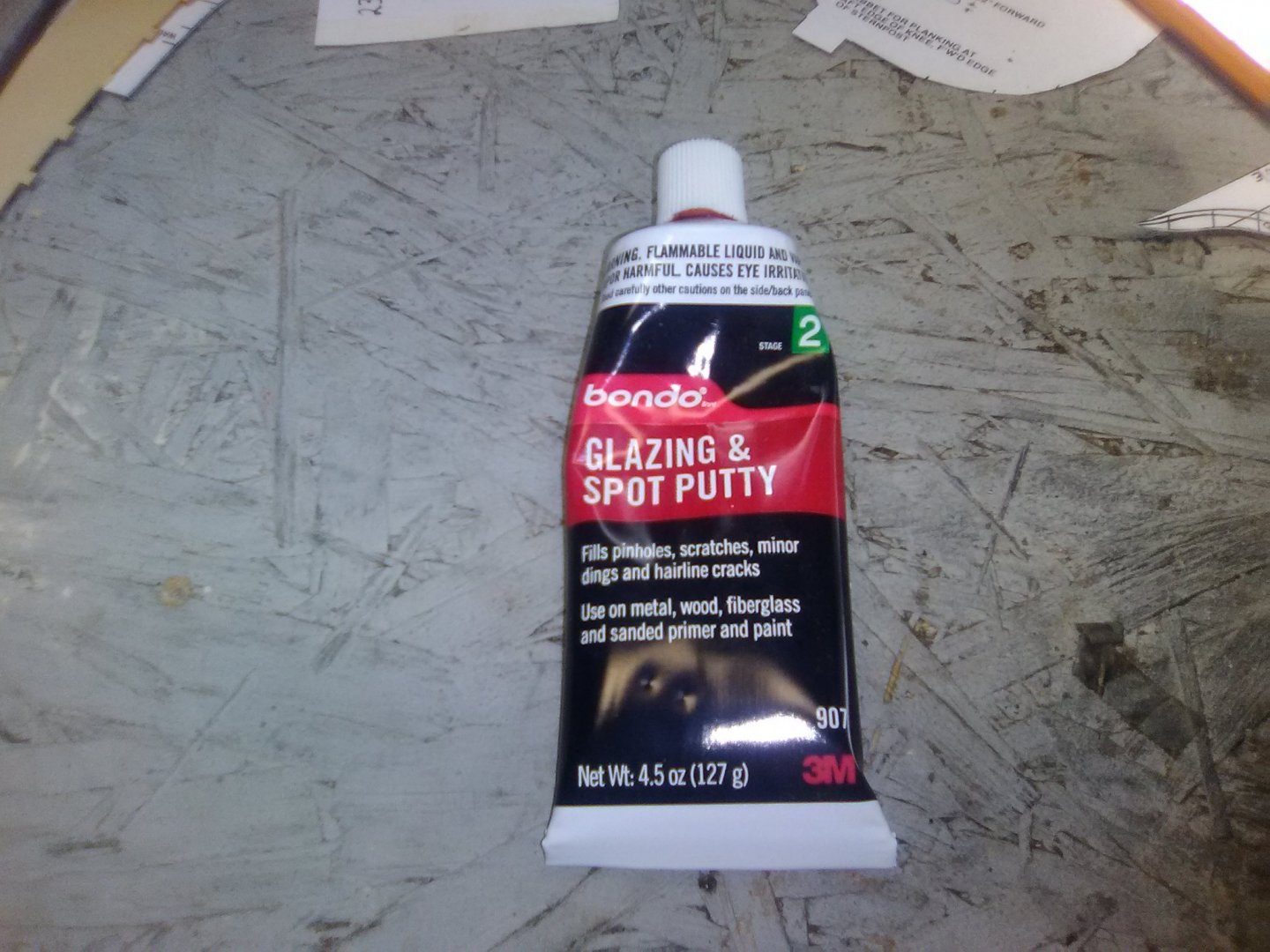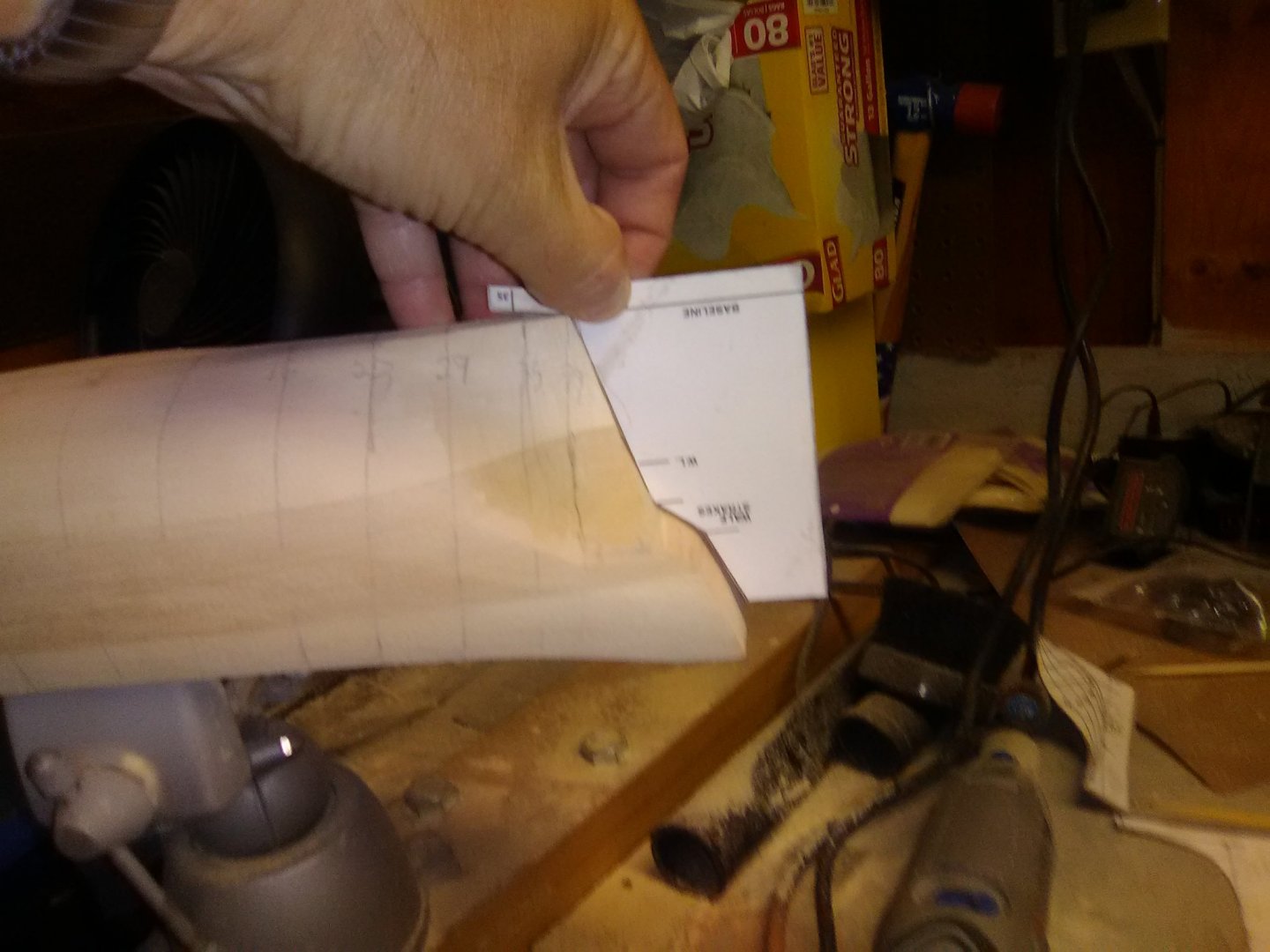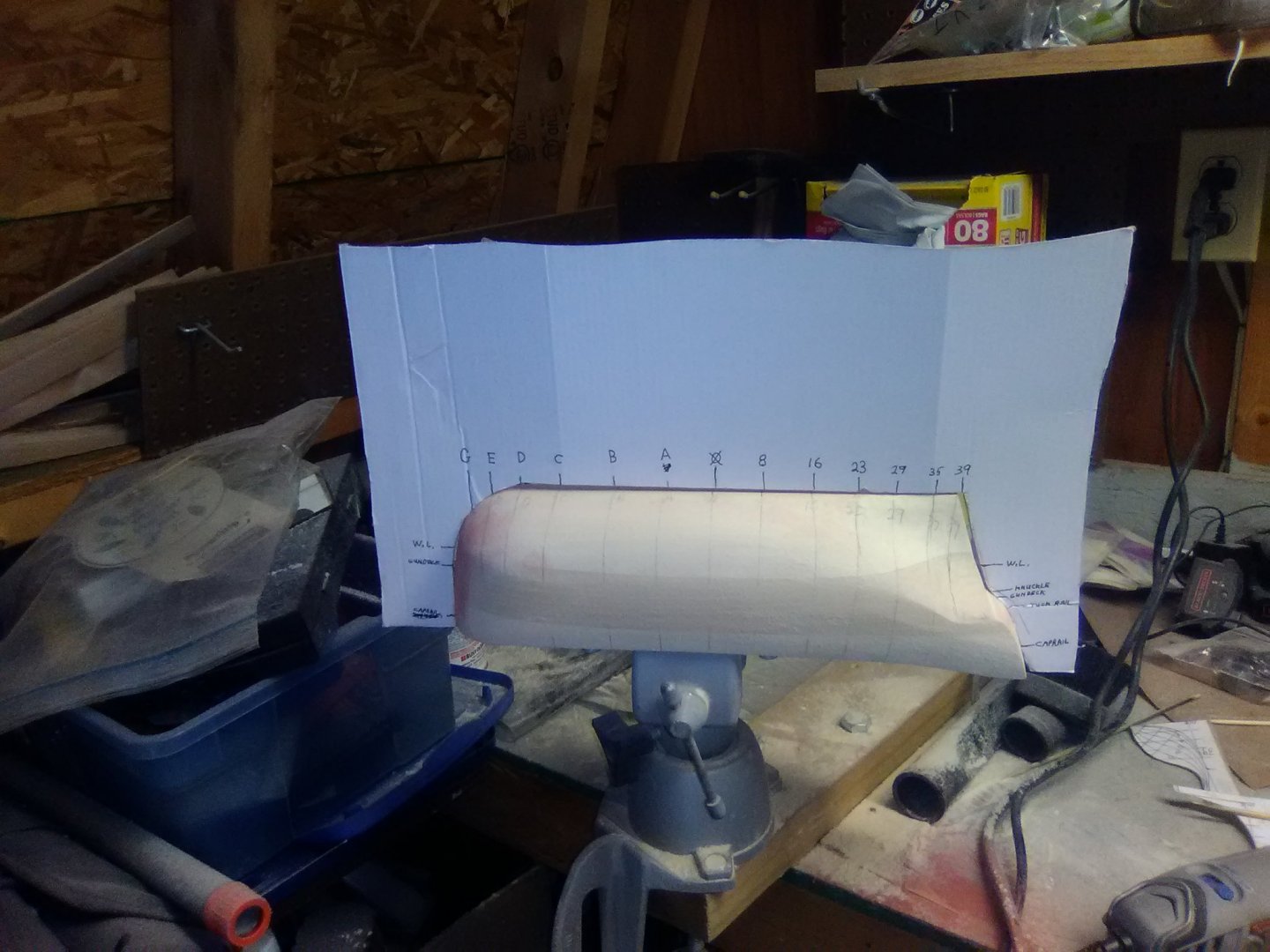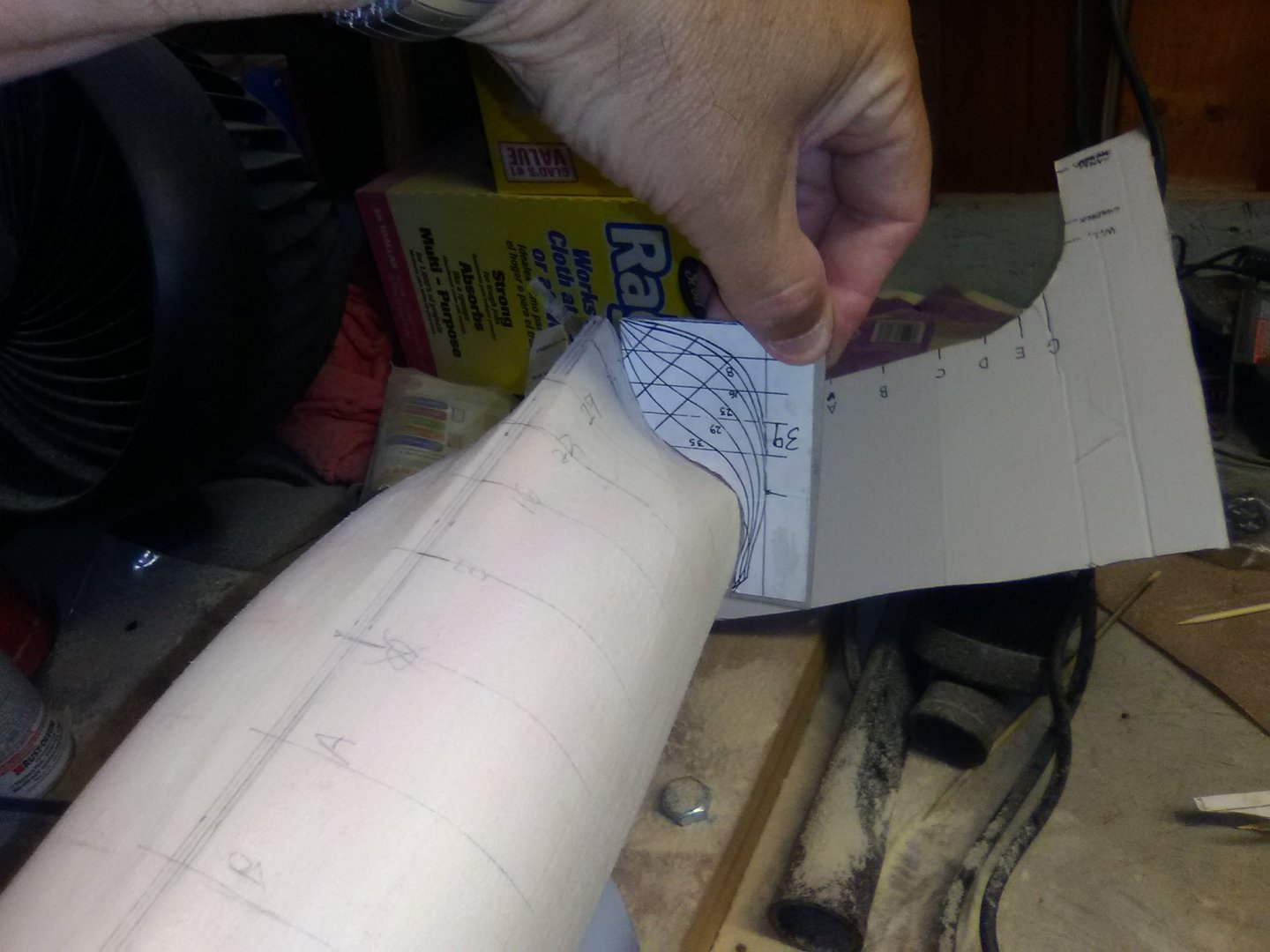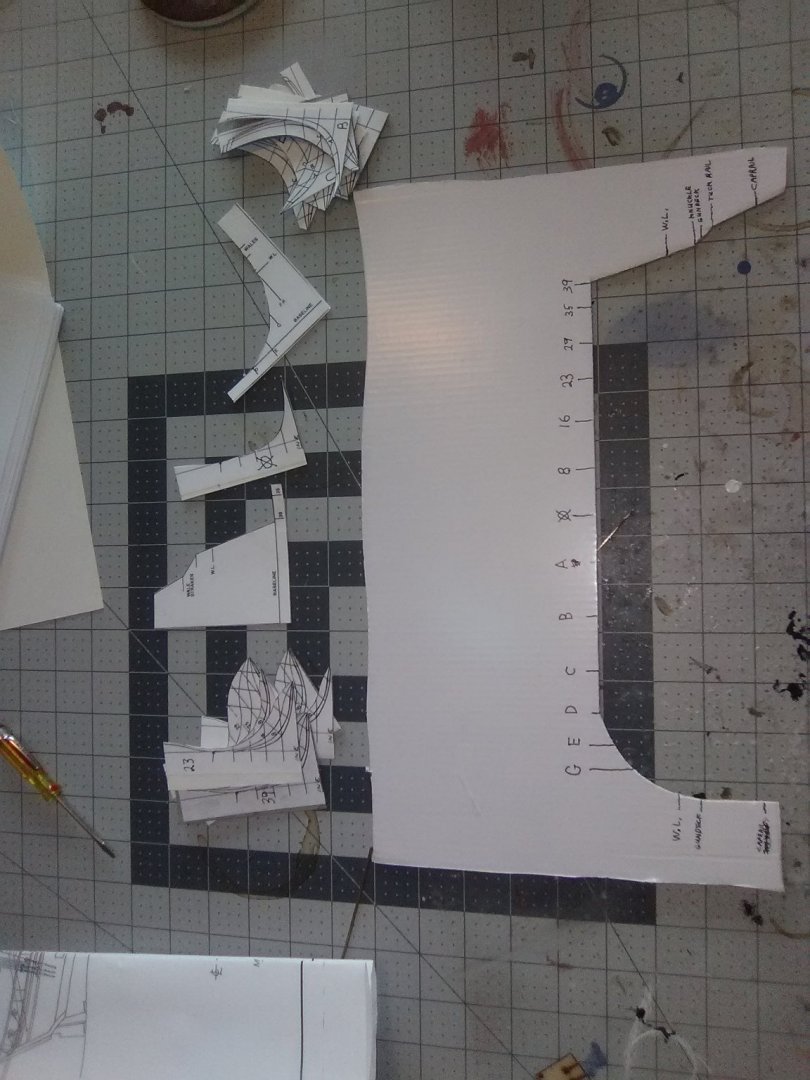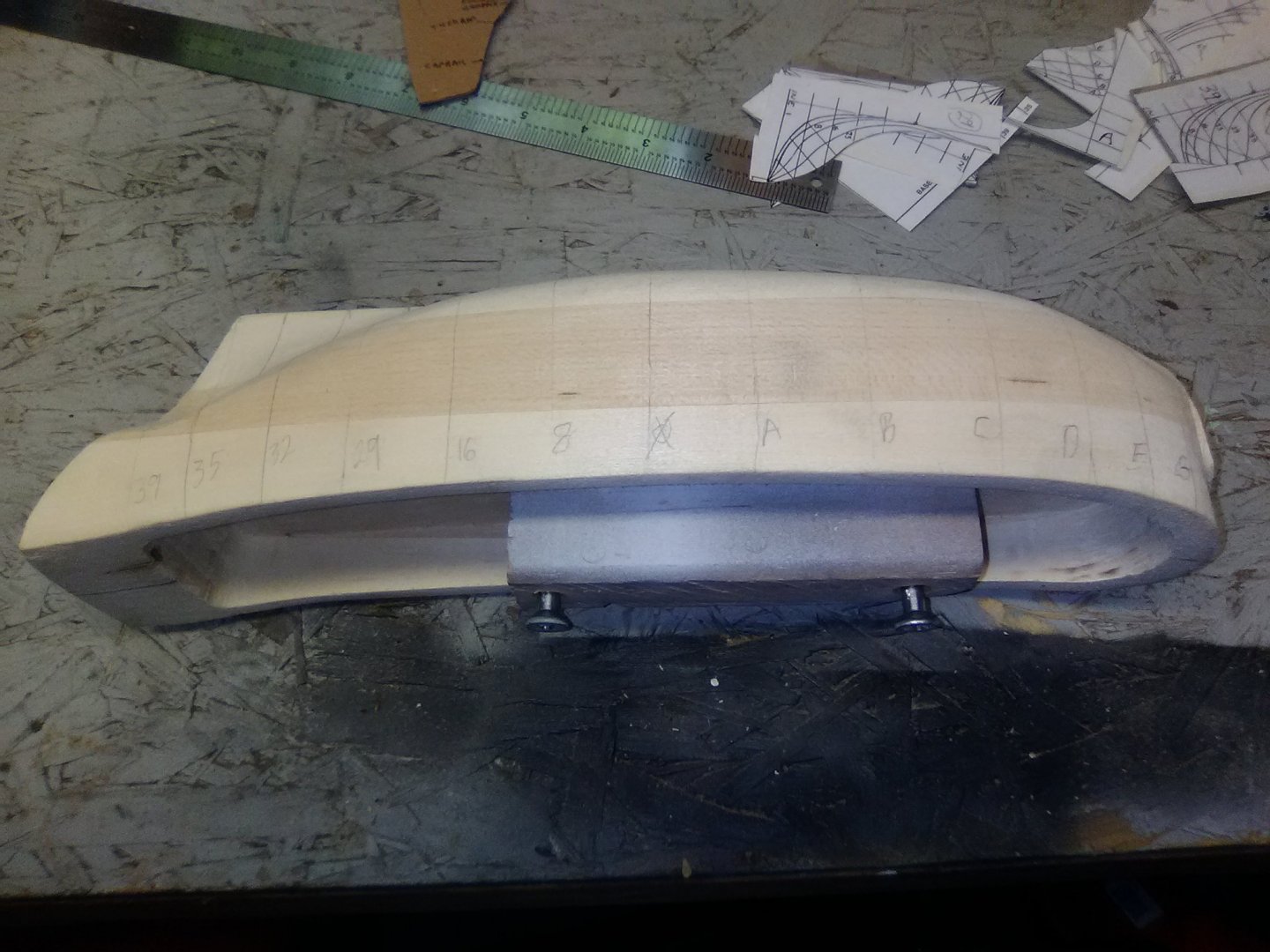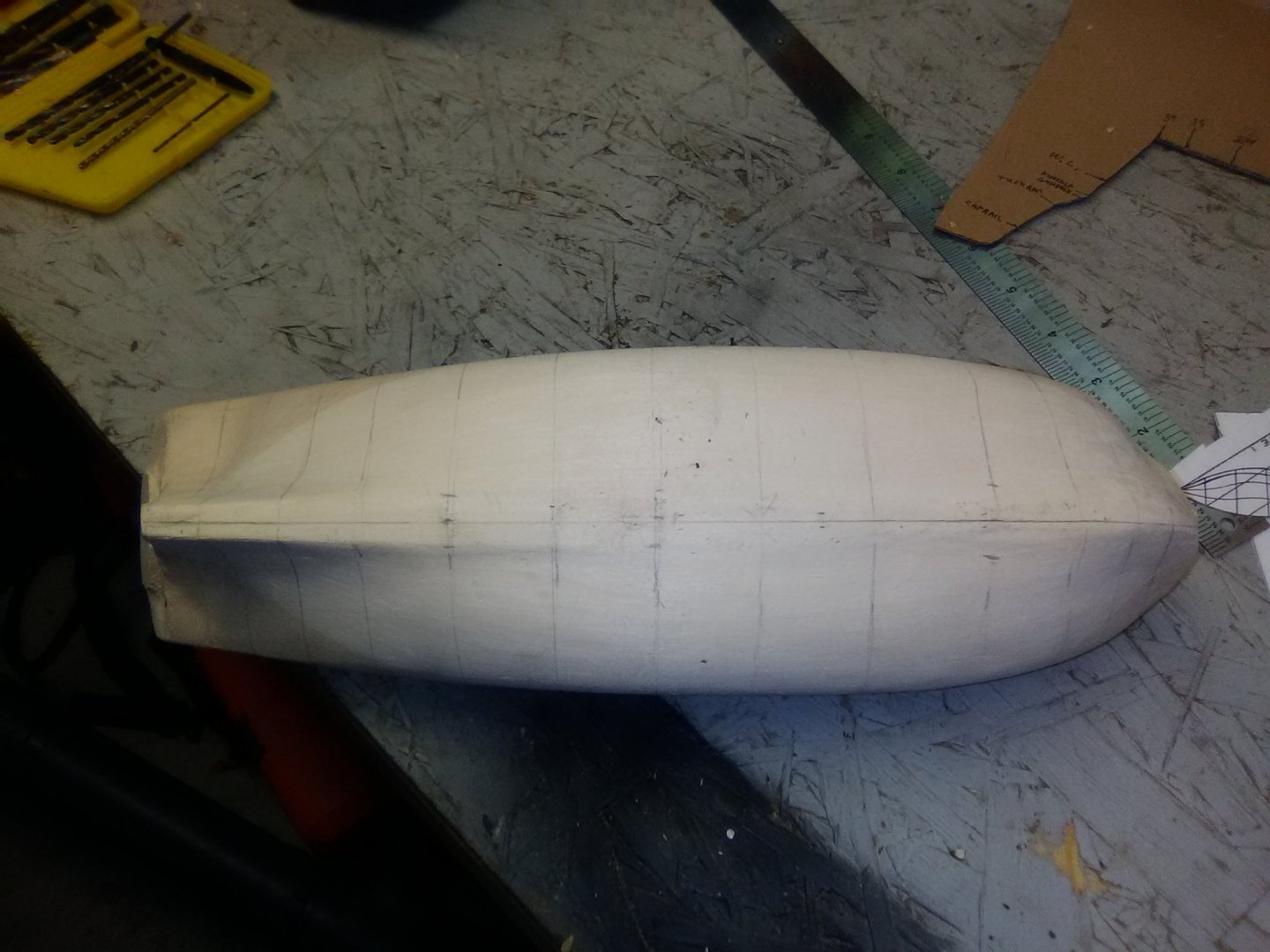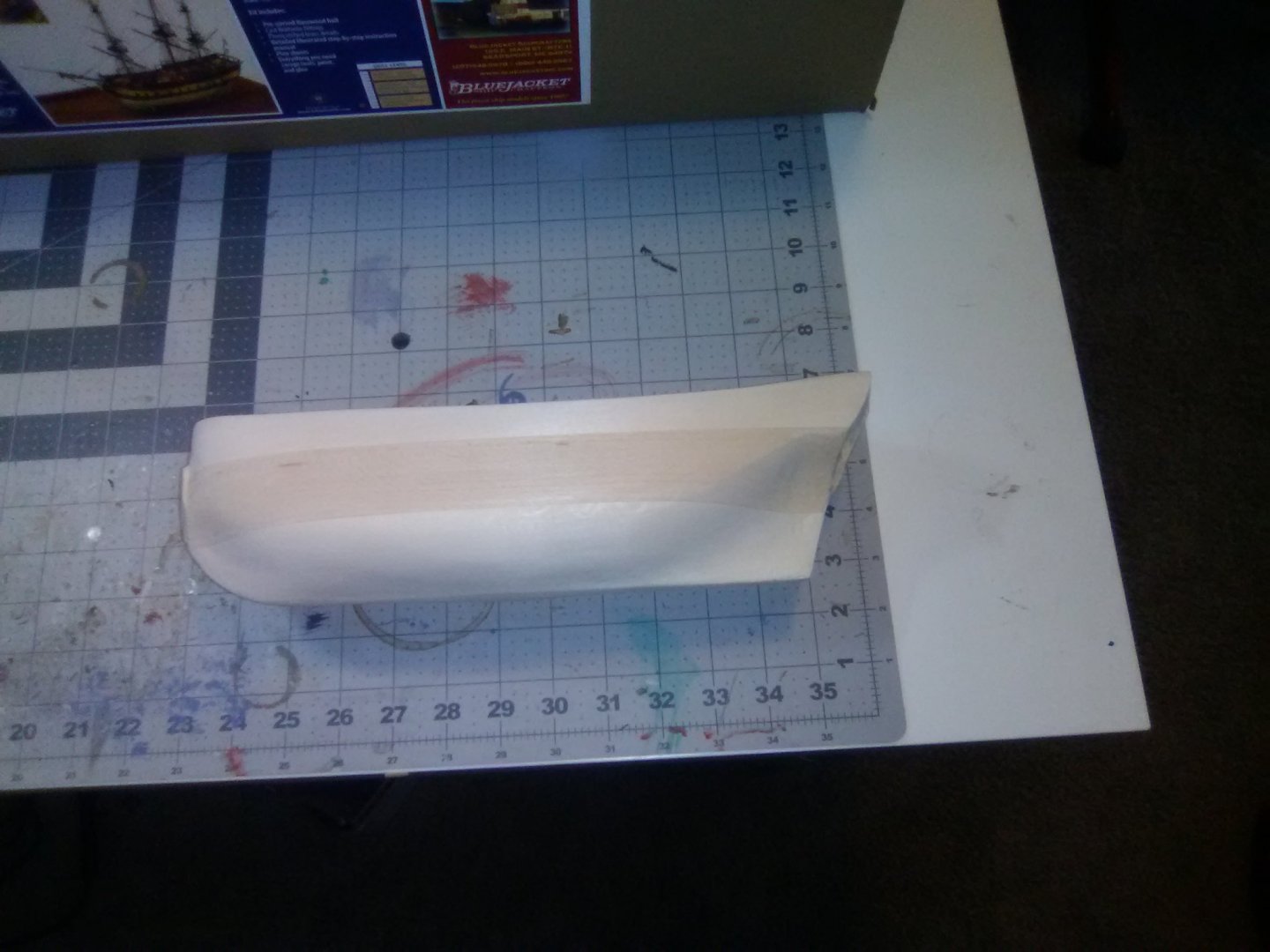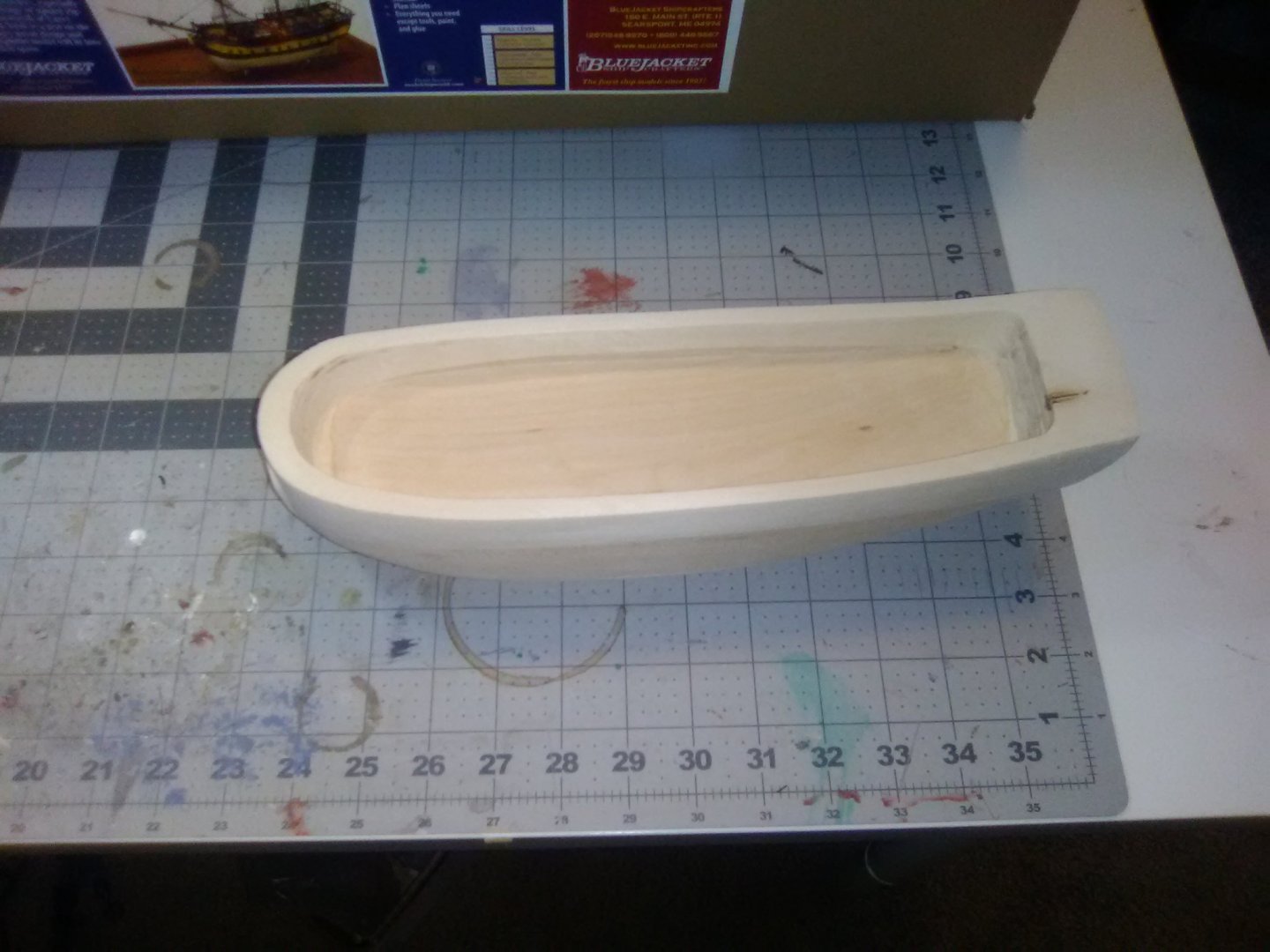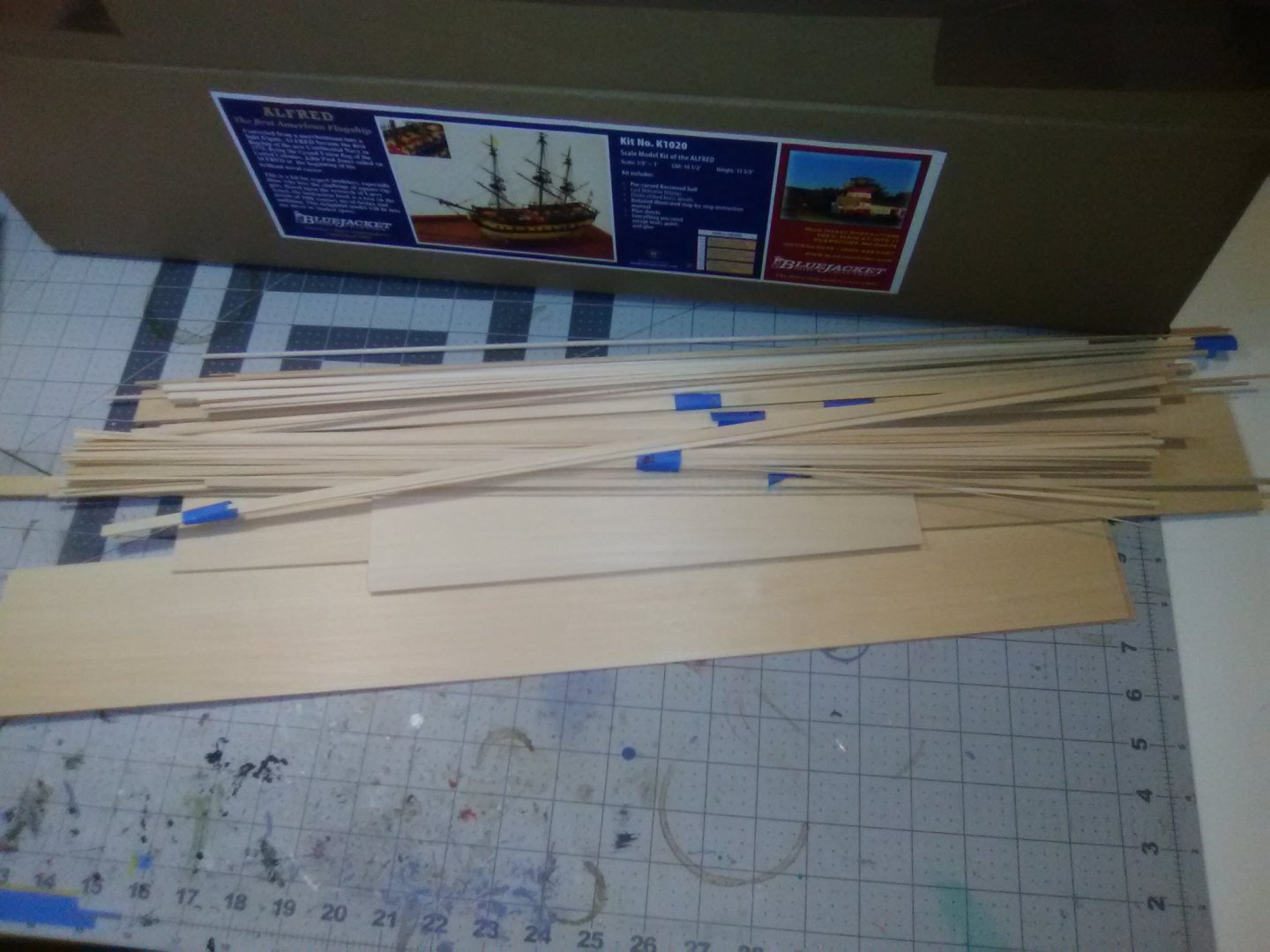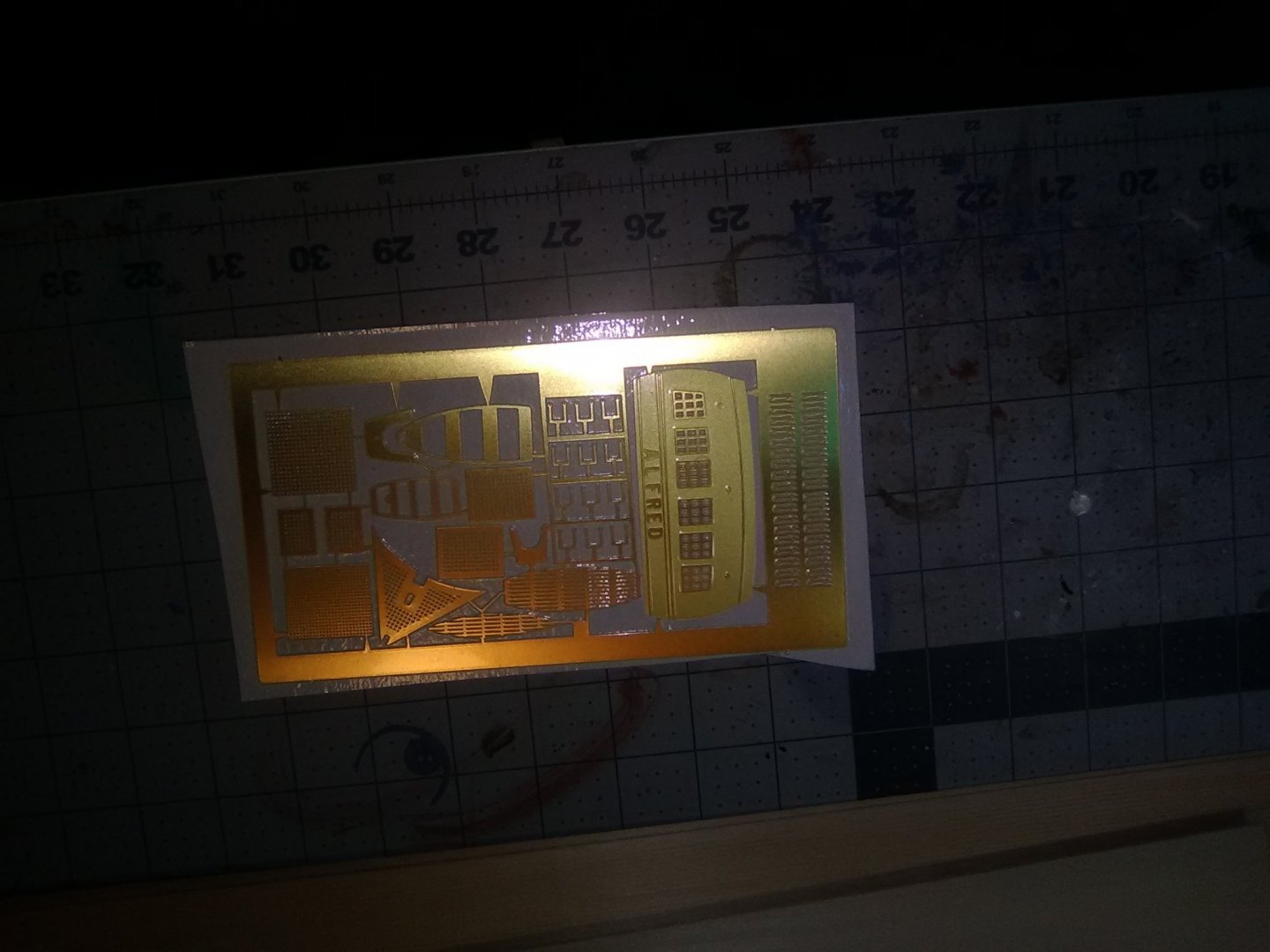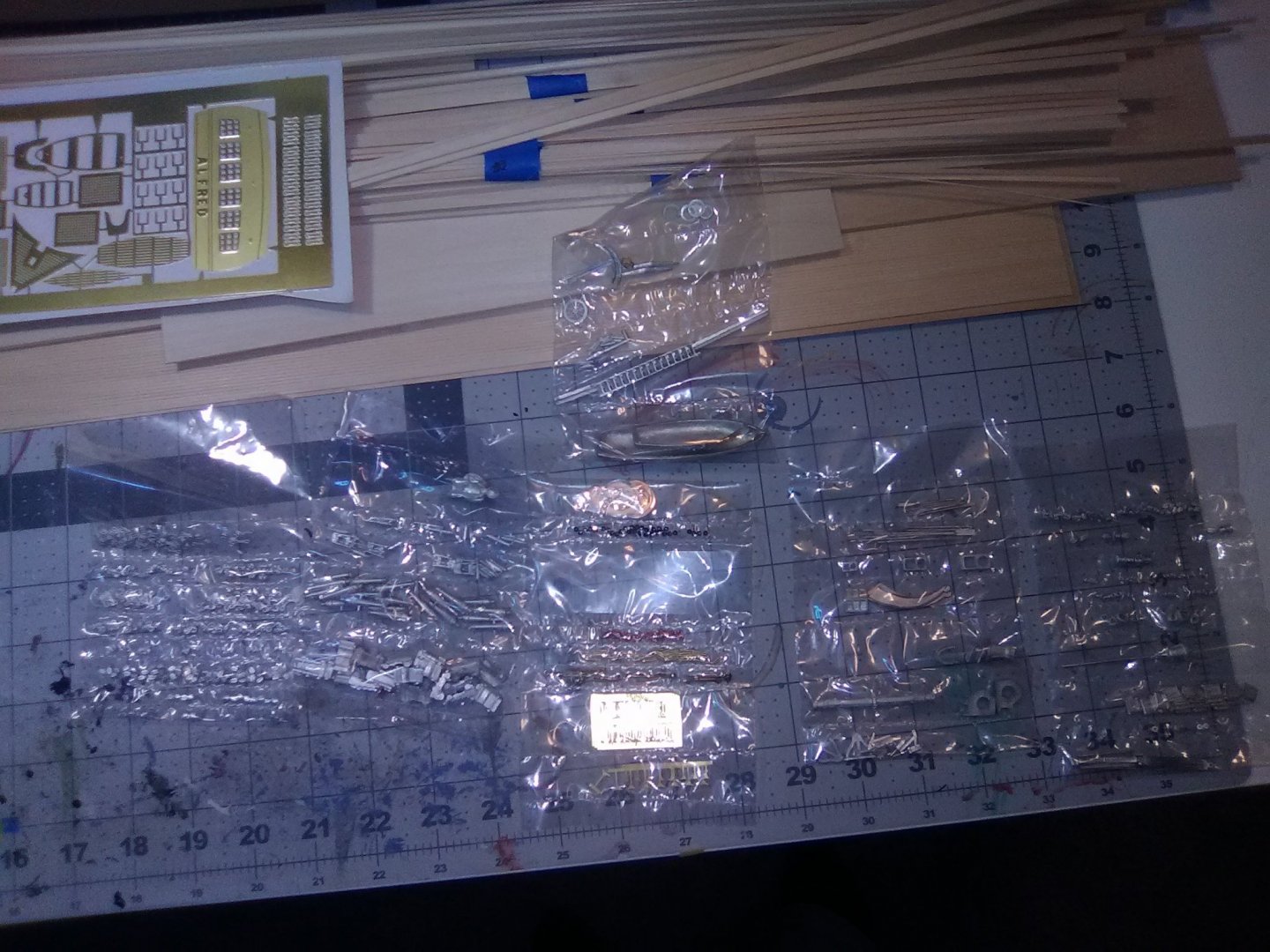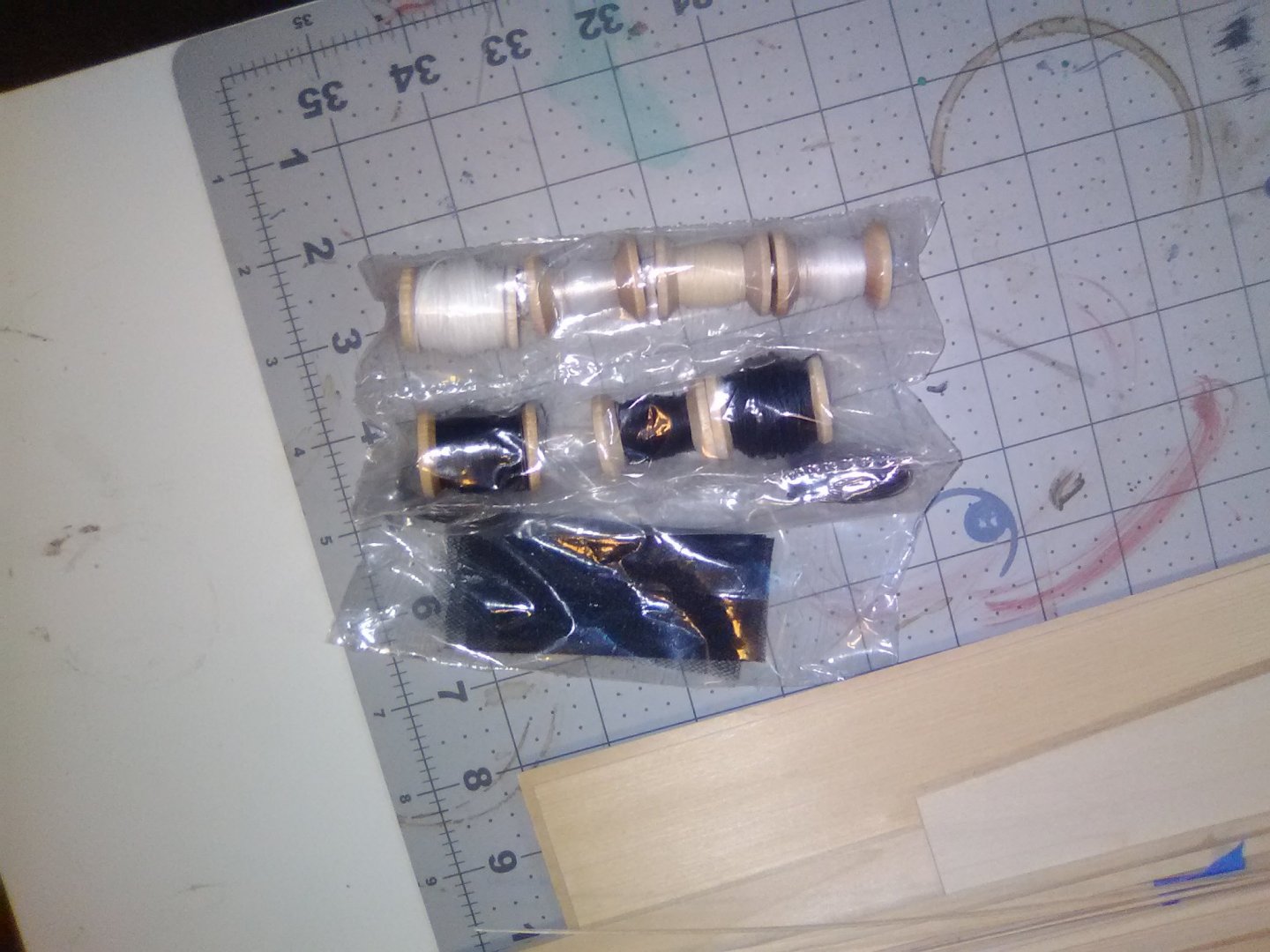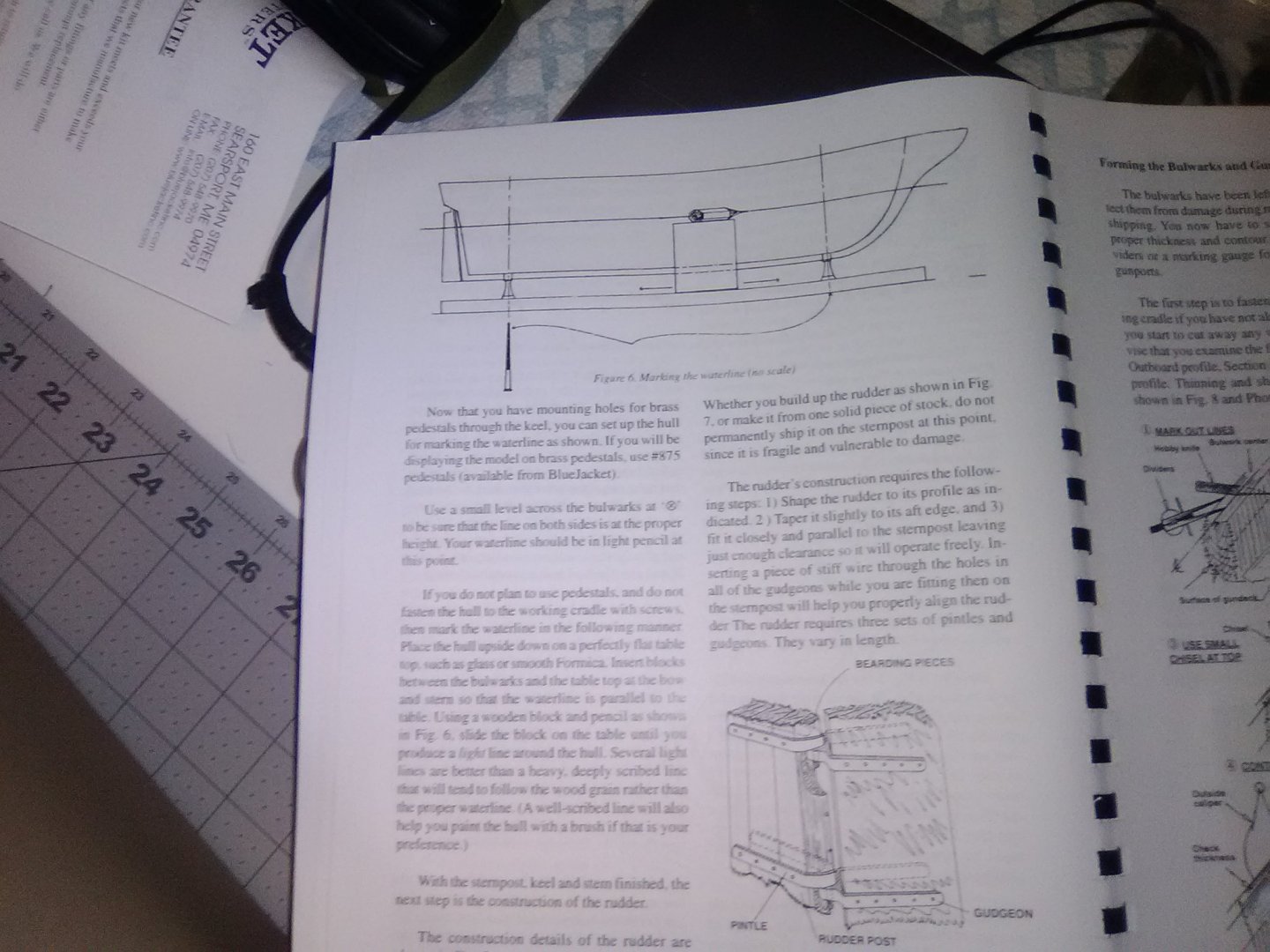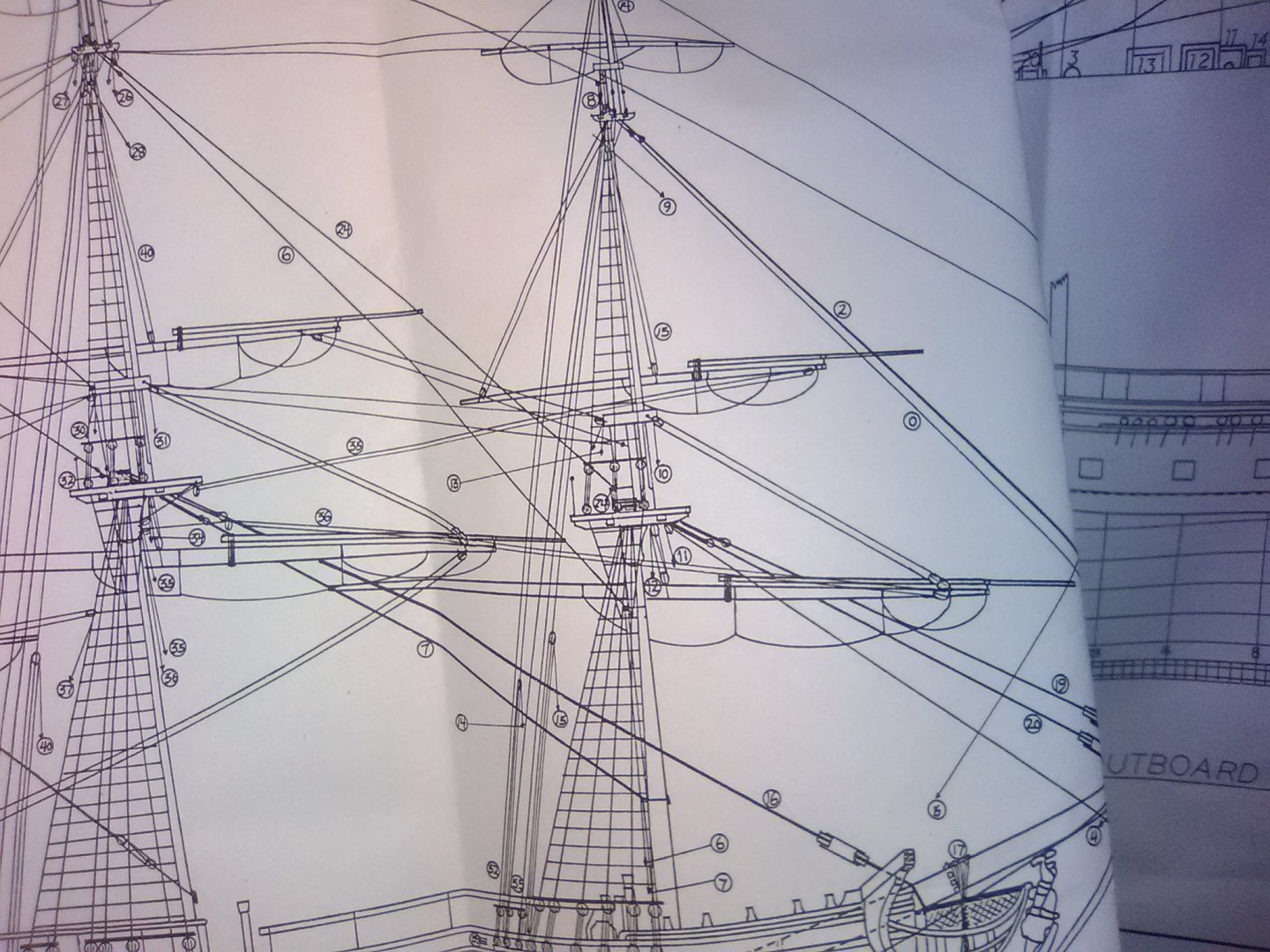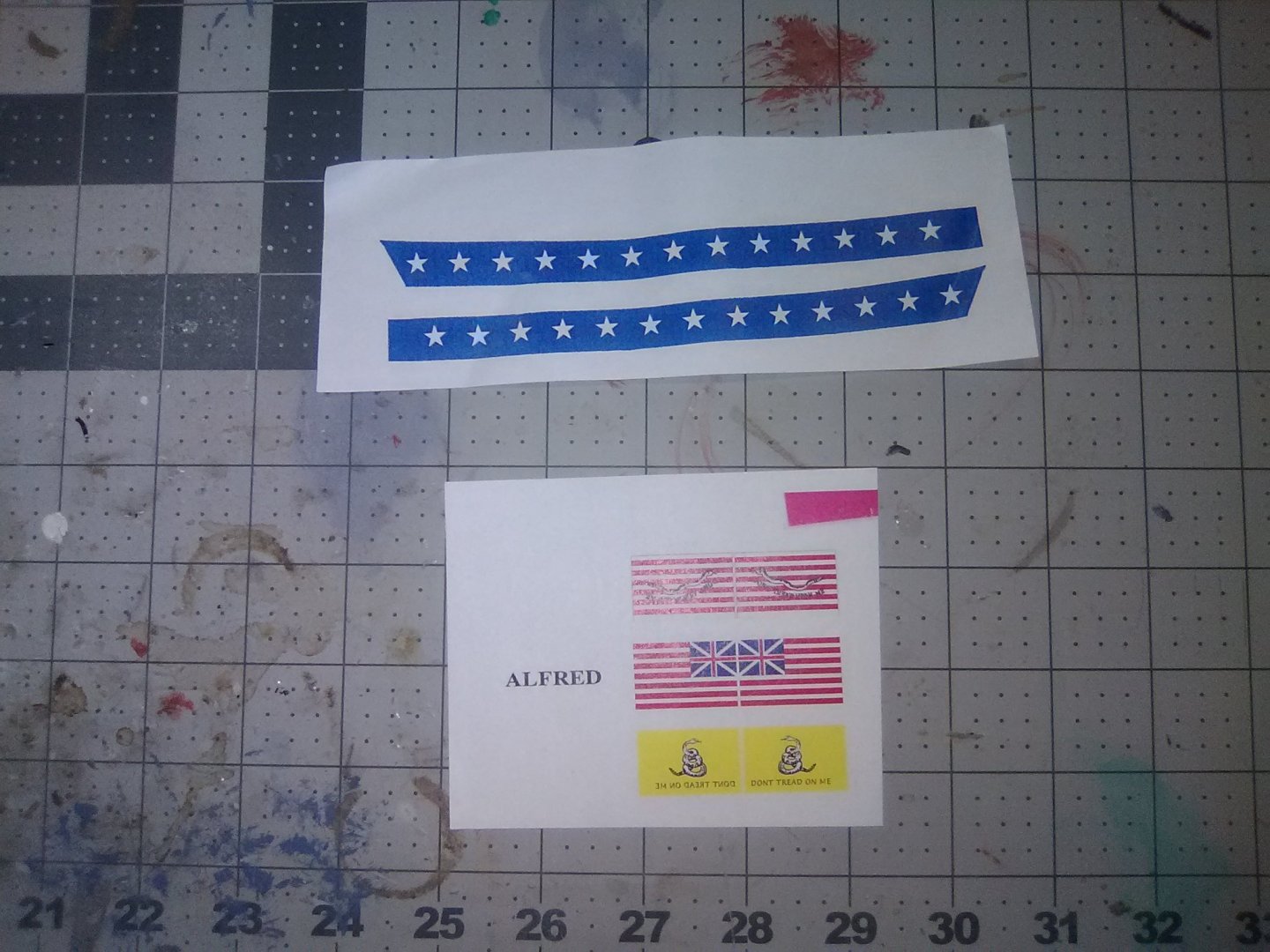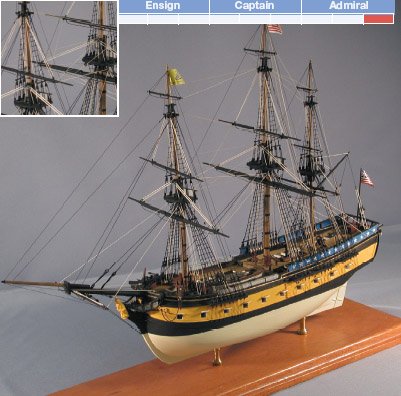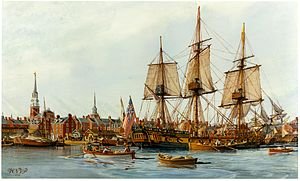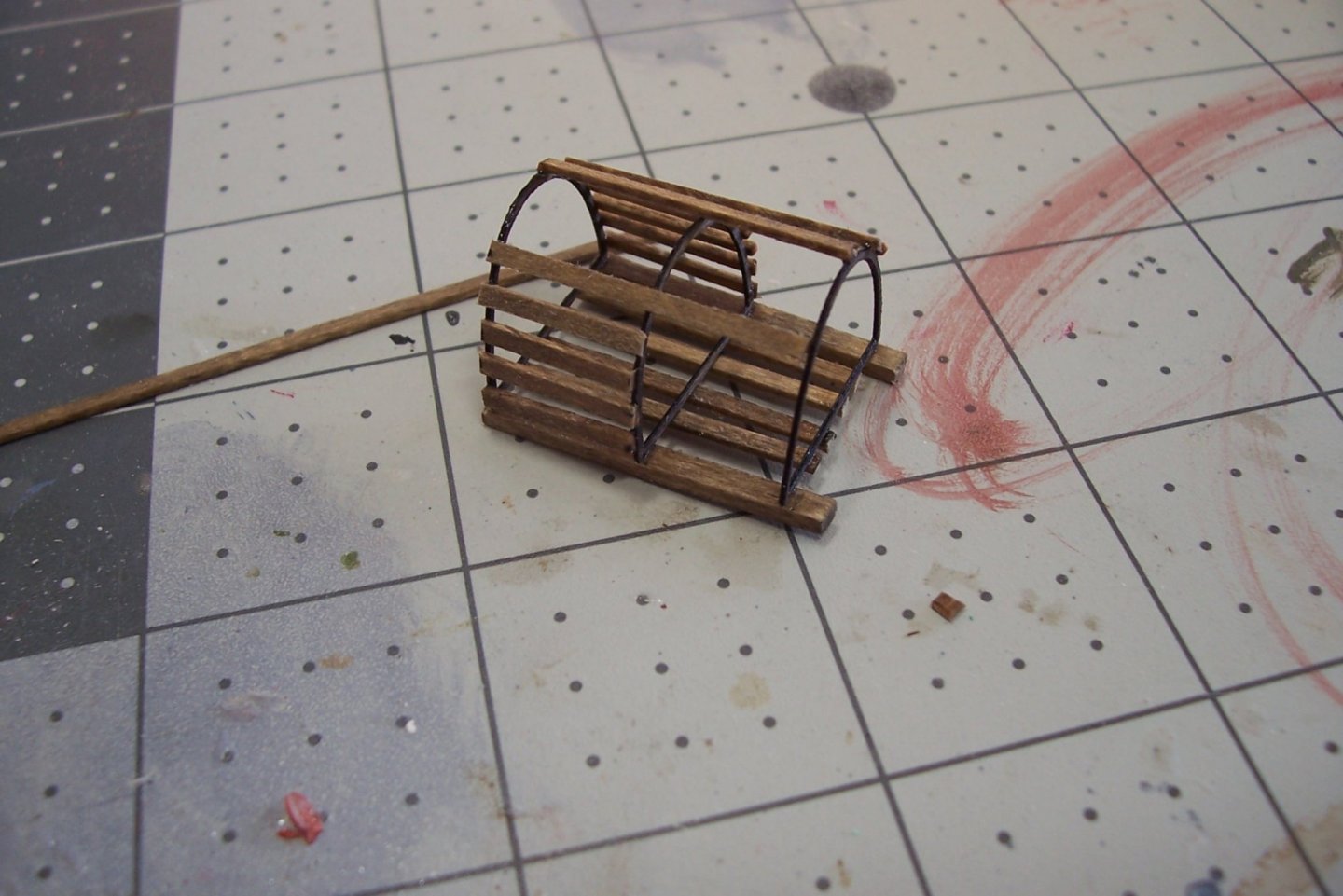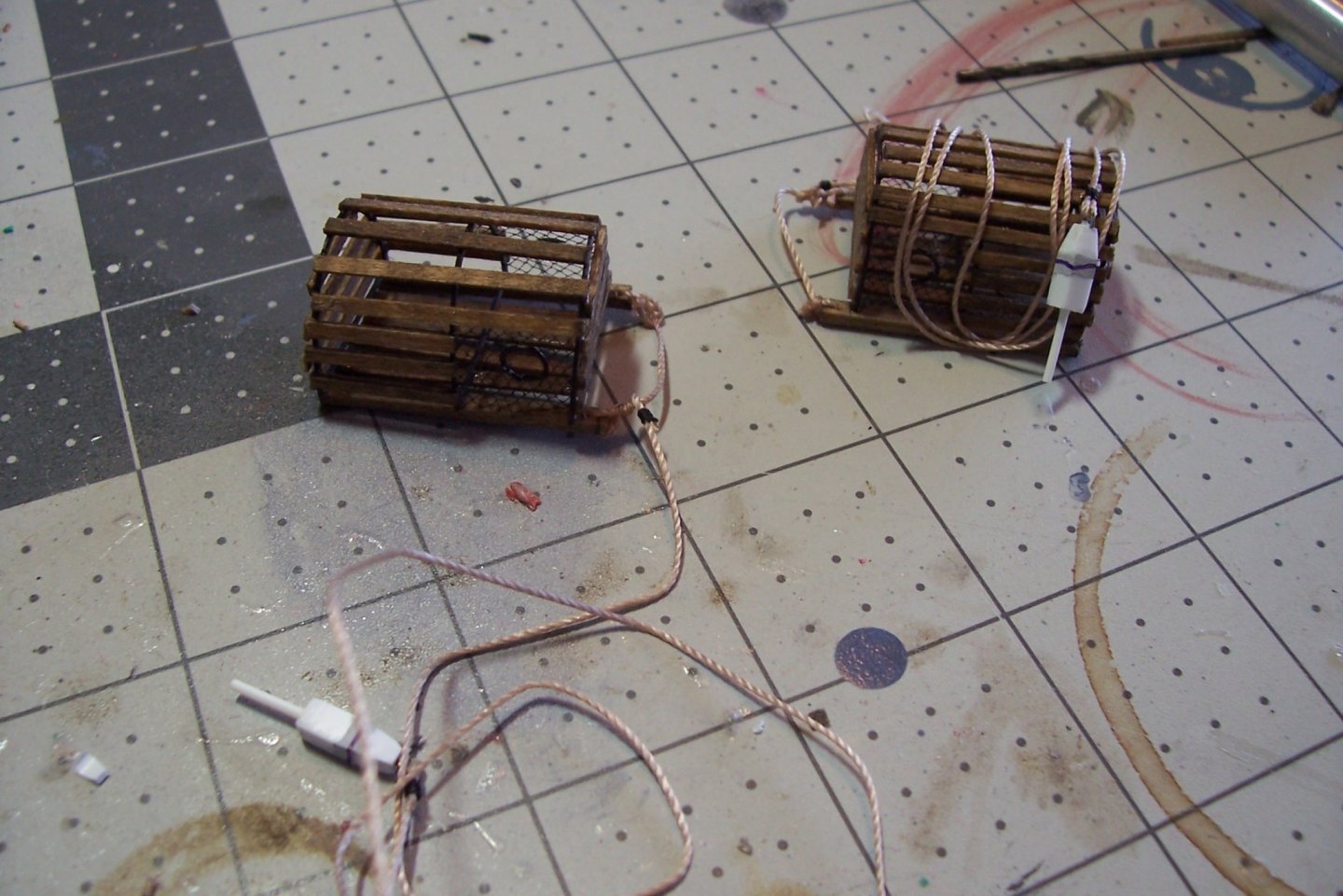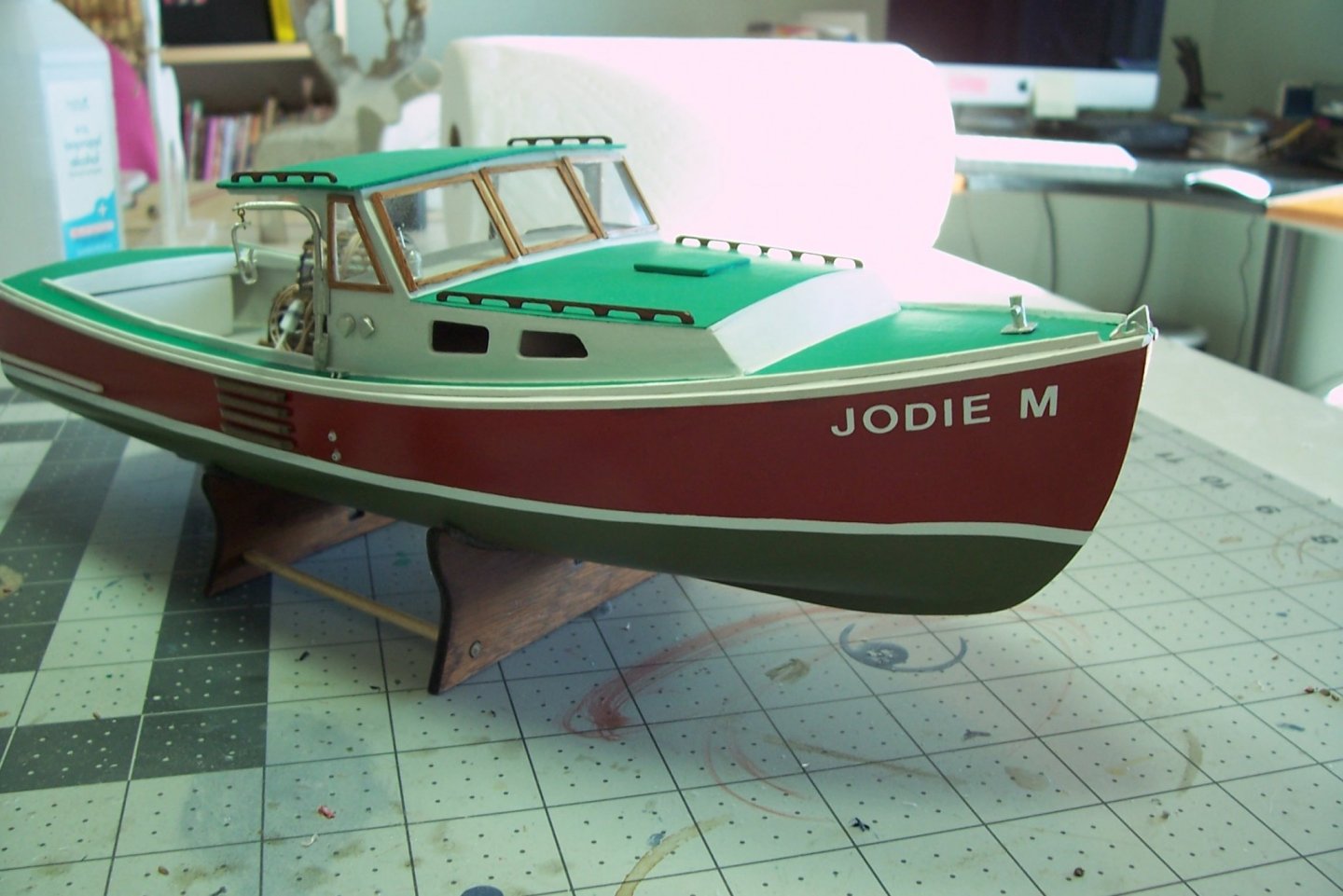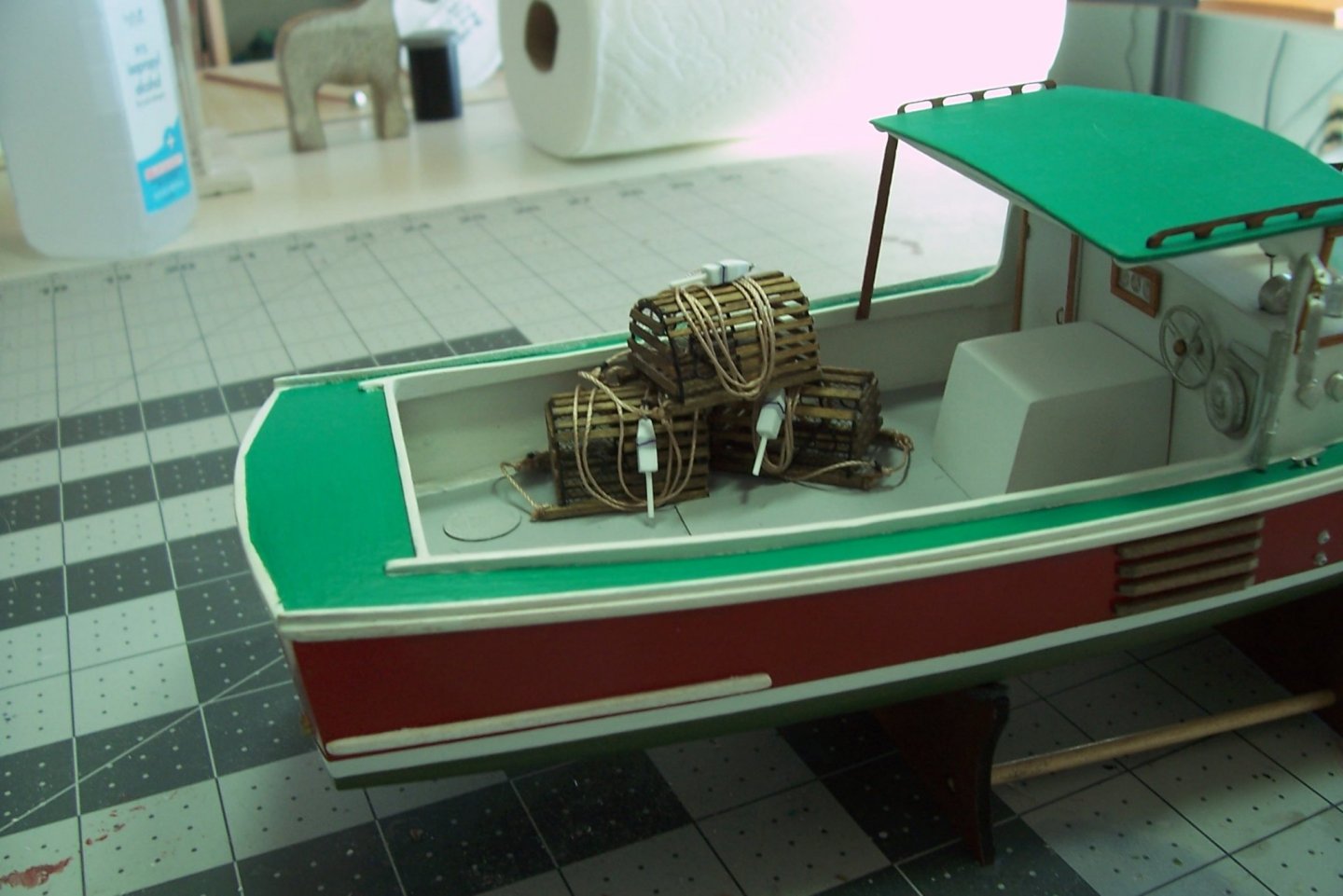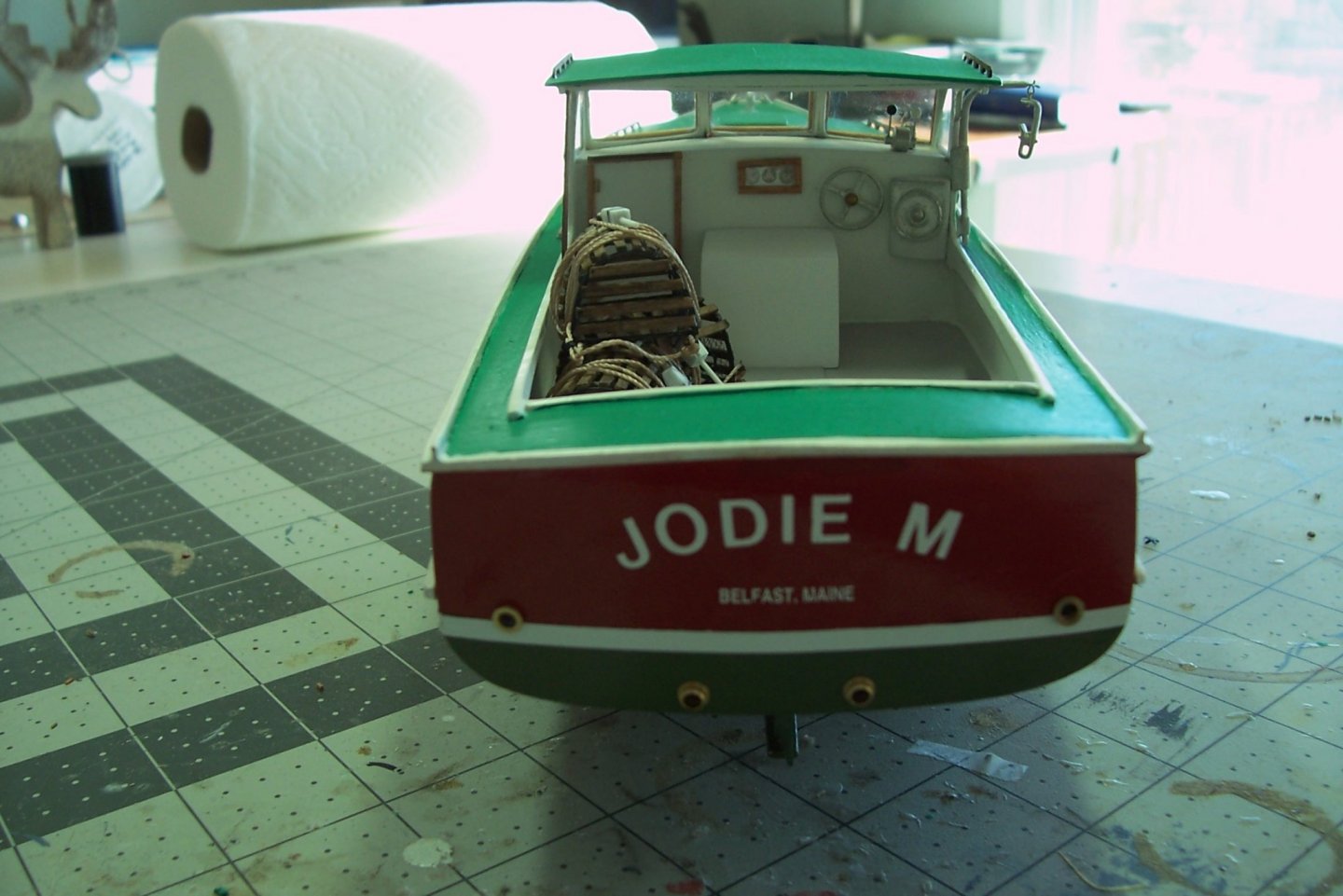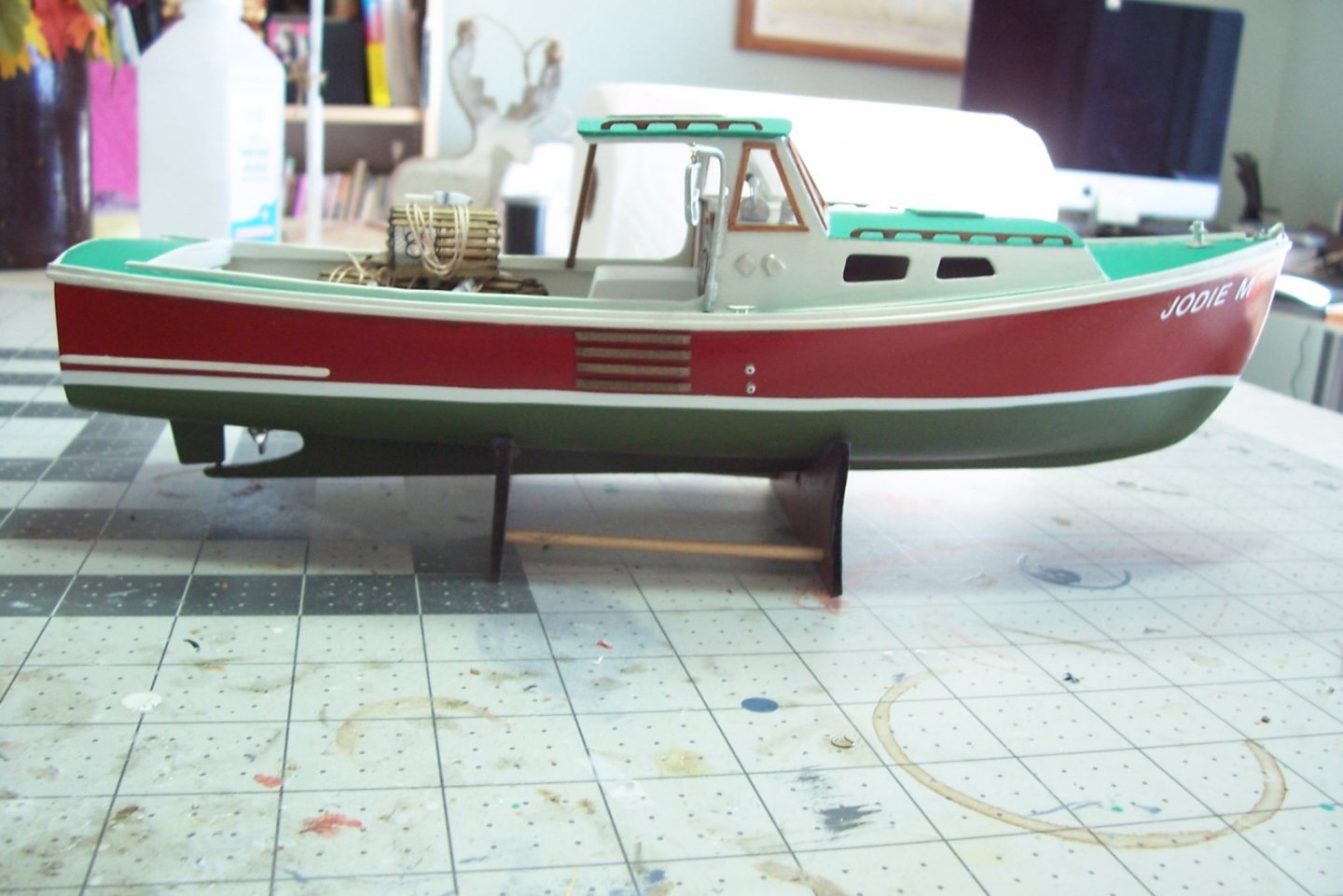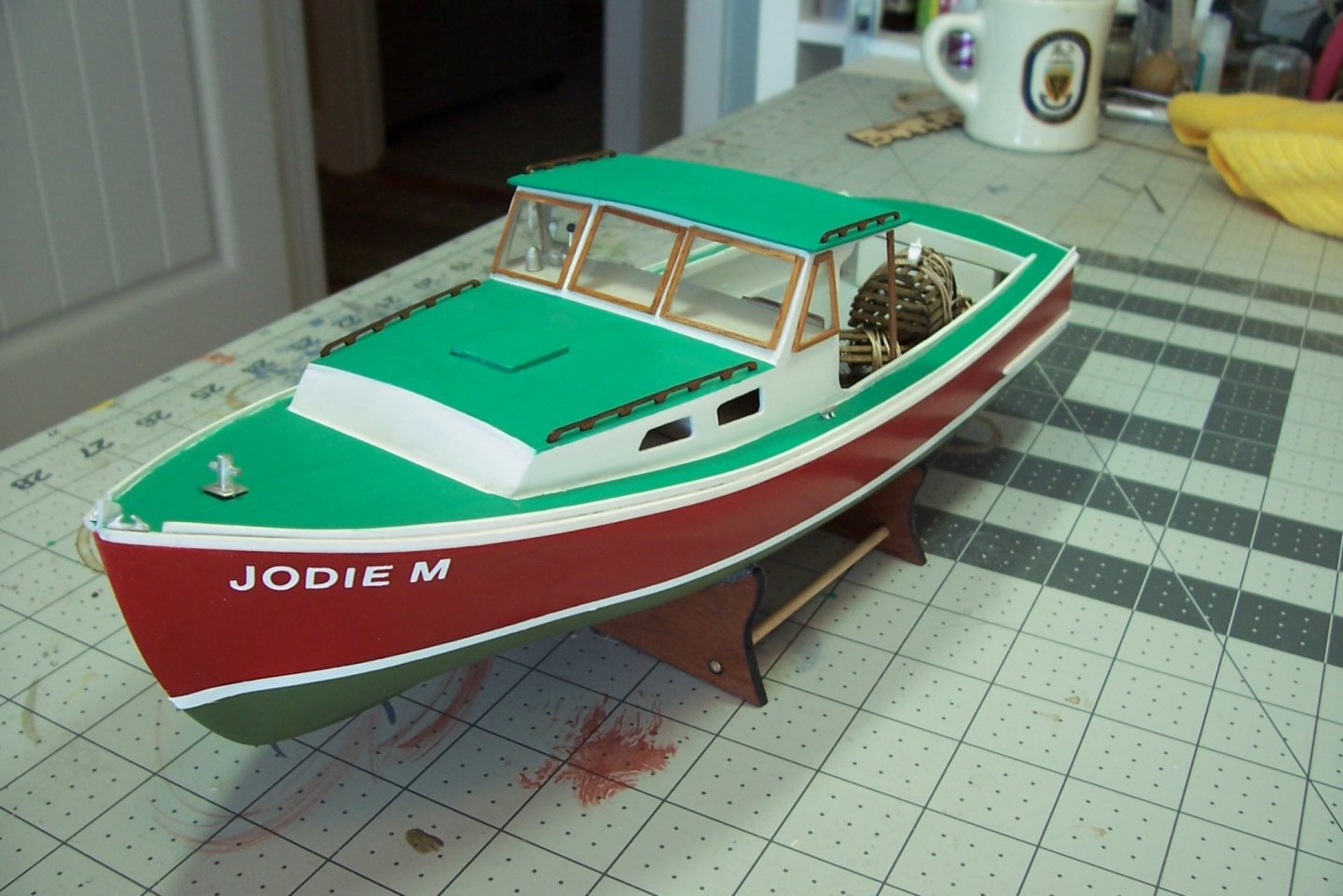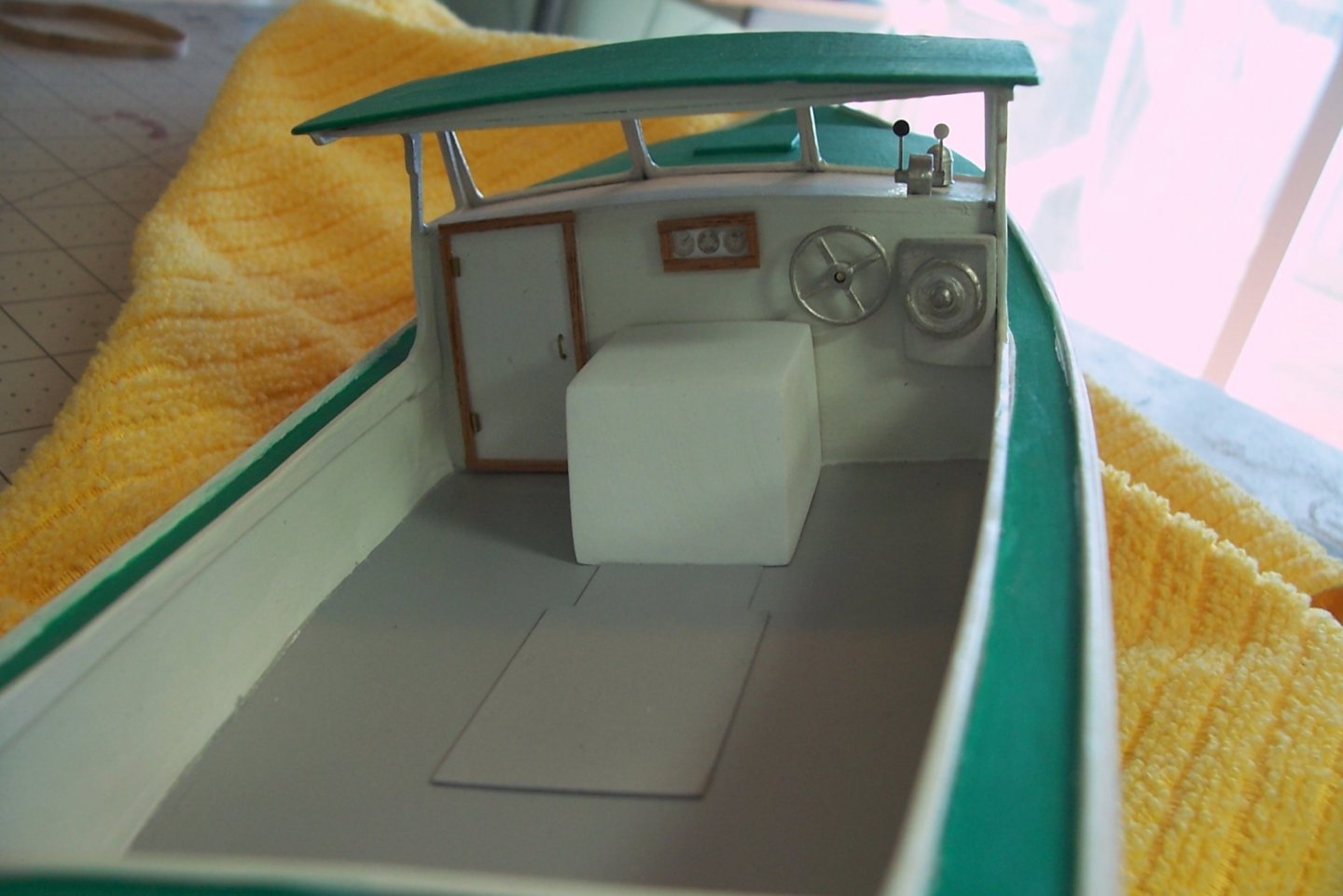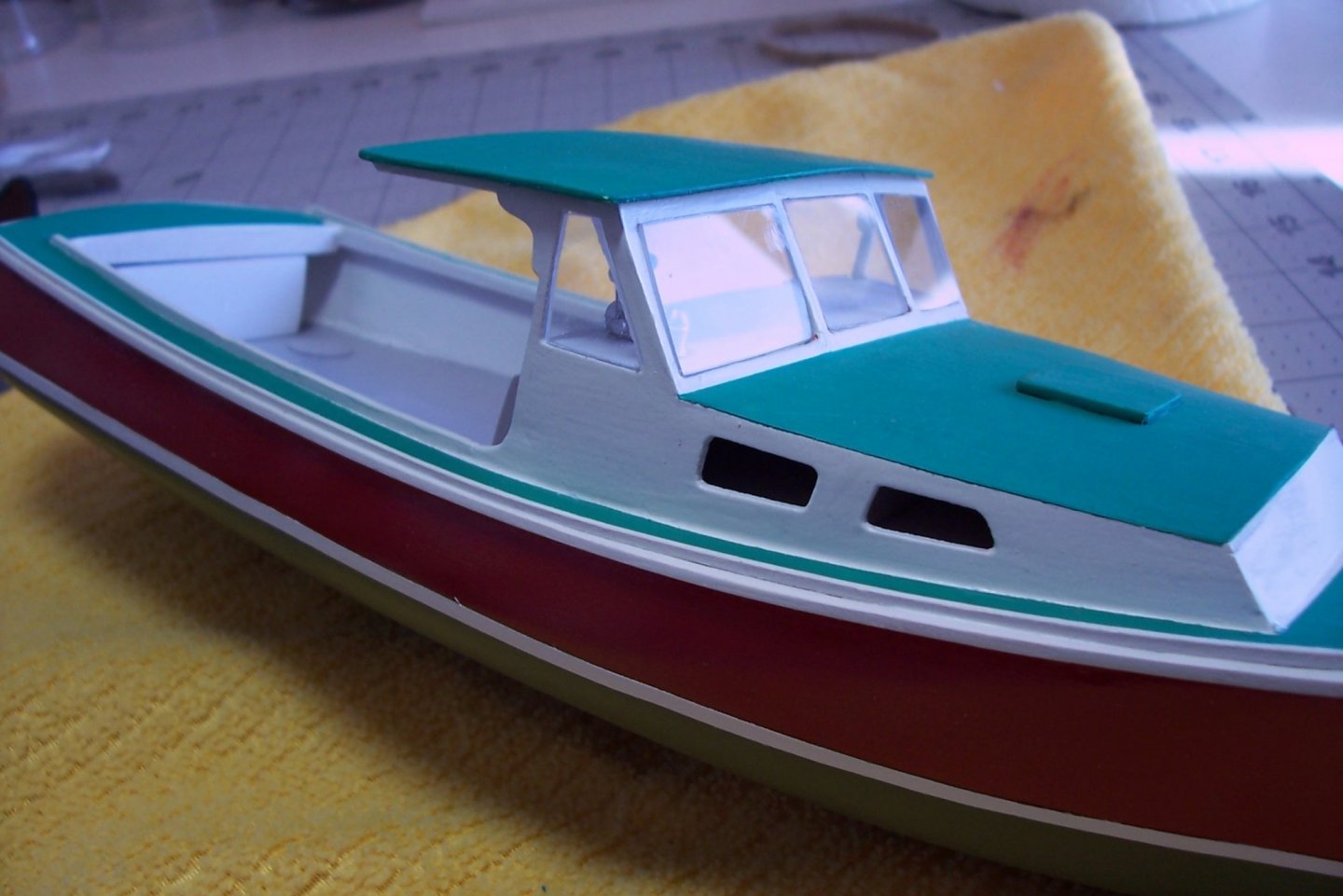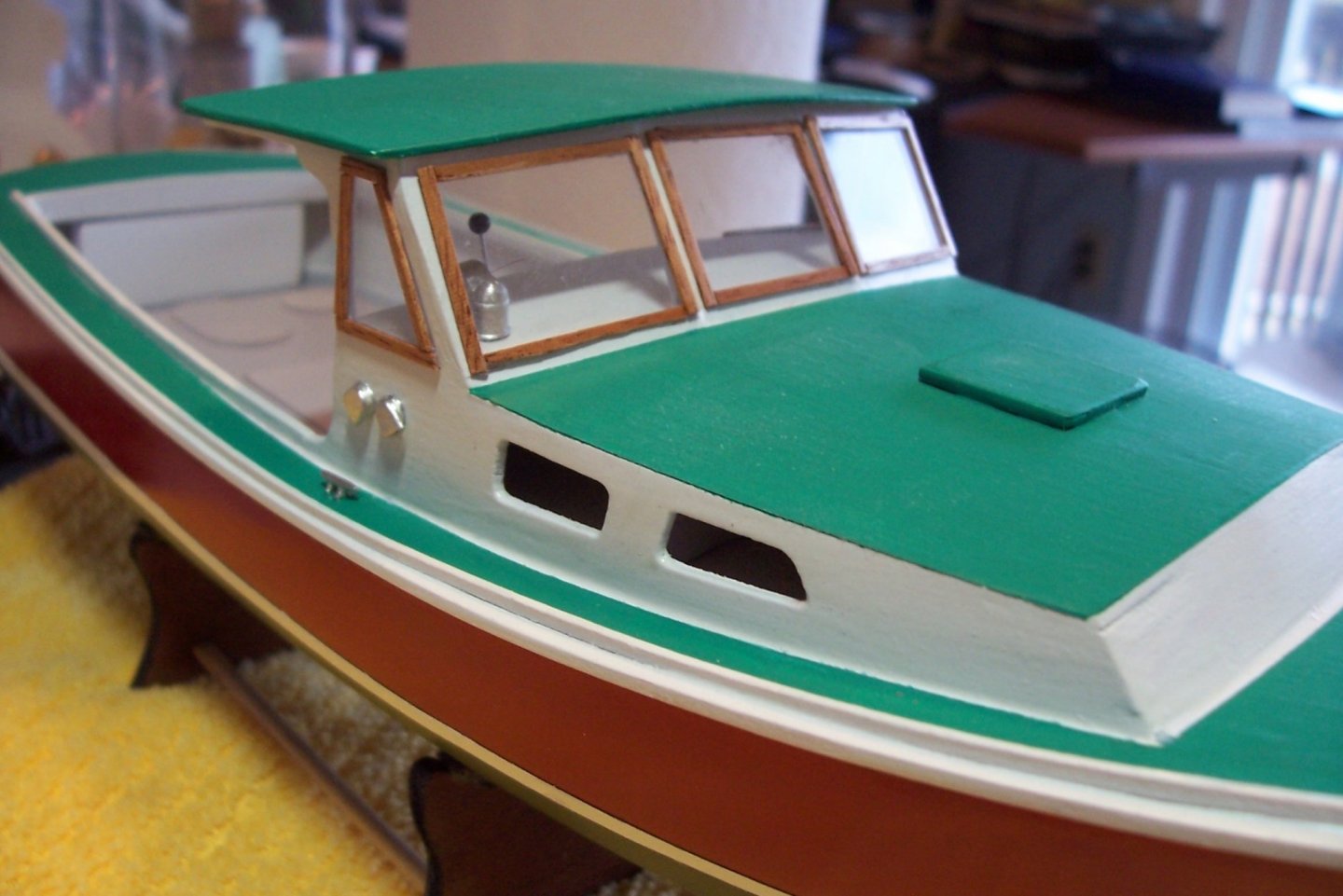-
Posts
738 -
Joined
-
Last visited
Content Type
Profiles
Forums
Gallery
Events
Everything posted by schooner
-
Hi Bruce, Sorry for the delay in getting back to you but I did not receive a notification of your posting. I'm happy to help with questions but it would be best to contact me via message. All you have to is go to my last posting in this log, click on "schooner" at the top of the box and select "message" and I will see it on my phone right away. That said, it has been about 8 months since I completed the kit and I don't have the direction book anymore (I should have kept it) so I can't work from part #'s but I remember the piece you are talking about. Yes, that piece may well be taller than needed which is good since it allows you to sand the top to get a snug fit with the roof piece. bear in mind that this piece has a definite slope when installed so you need to sand the bottom edge so that when it is laying against the side pieces the bottom fits the deck with no gaps. I can't remember if the deck had much camber in it (the center higher than the outboard edges via a gentle curve - helps water drain off) but if it did you may have to sand a little more off of the center of the bottom than the outboard edges. Once you have a good fit, glue it in place. Take the roof and test fit itif the C4 part is too tall start sanding the top edge, remembering that the top edge will also have a bevel in it since it is on a slant. keep sanding a little and test fitting a lot and you should get it to the point where the roof is in good contact with the cabin sides and C4. If you really screw up C4 you can tear it out and make a new one using the laser cut fret you cut it out of or using tracing paper to make a copy of the plans and then glueing it to the right thickness of wood and cutting it out (something you can do for most parts in that kit) let me know if you have any more questions. Tim
- 20 replies
-
- red baron
- lobster boat
-
(and 2 more)
Tagged with:
-
More Hull Work The directions call for fabricating the rudder at this point, not sure why but I did it anyway. It is just 1/8” stock cut to a trace, forward end round, aft end tapered and the “planks” imparted by running a hobby knife along the pencil lines and then doing it once more with the back side of the blade tip to leave lines that should hopefully show up after it is primed and painted. The gudgeons (or pintles, I can never keep them straight) are britannia metal. The instructions also call for adding the stem extension, small knee and test fitting the head grating at this point. This was a real head scratcher because the directions were referring to having the grating contact parts that will not be added for a long while yet. I think it was just a case of getting carried away with the copy and paste function while assembling the instruction book. Note from later in the build: DO NOT fit the head grating yet - its' aft edge has to fit the PLANKED hull right at the level of the main deck (which you can't tell where that will be at this point) so wait until it is time to build the ship's head (much later than now). Before I could mark out the bulwarks for thinning I had to remove some excess material from the aft ends so that the bulwark shear line is straight. The material to be removed is shown by the cross-hatched pencil marks. I had to think a while about how to lay out the bulwarks for thinning. The aft 3/4 have noticeable tumble home (i.e. they curve inward) but up where the bow starts to curve they are vertical. By marking the centerline of the existing bulwarks all around the hull then laying out parallel lines on each side to show the final 3/32” width I was able to mark where the inboard and outboard lines began to curve and marked that as the end point for the tumble home. Where the outboard line touches the current outboard edge of the bulwark will be the point where the 3/32 width will be measured from the outside of the existing bulwark all the way around the bow and material in that area will only be removed from the inboard side.
- 142 replies
-
- alfred
- solid hull
-
(and 2 more)
Tagged with:
-
Great Job! I built her a few years back - best laser cut wood I've ever seen. Love the mounting stand!
- 17 replies
-
- martha
- chesapeake bay maritime museum
- (and 2 more)
-
Keel Installation and Building Board The keel, stem and sternpost are all glued and pinned in place now and the hull faired into them. Although I have just started this build I have learned from bad experience that I need to figure out how the finished model will be mounted and take care of any drilling and blasting now rather than wait till the end and try to mess around the keel of a finished model. That said, I ordered the pedestal set for this kit from Bluejacket. The instructions caution to be careful when drilling the holes for the mounting screws into the keel because “they are almost as wide as the keel” Actually the threads on the screws are 1/8” wide, as is the keel so there is no way to screw them in without damaging the keel. Fortunately, the slots on the pedestals are 3/16” wide so I was able to glue 1/32” sheet wood on each side of the keel where the pedestals will go to provide additional thickness for drilling the screw hole - it also works out well because now the pedestal fit very snug to the keel so the model will be that much more better supported. All the station marks have been added to the hull as have the locations for the waterline and wales on the stem and sternpost. The next step is to build the building board. The kit instructions provide all the info you need. The only modification was that I made 4 supports rather than just 2 that the instructions called for - with only a coping saw and a Dremel sander the more elaborate supports the instructions called for were just too complicated for me. The supports are not a perfect fit but with the felt liners they provide plenty of support to the hull. I have a few small things to add to the stem area and then it will be time to trim down the bulwarks - should be a real treat.
- 142 replies
-
- alfred
- solid hull
-
(and 2 more)
Tagged with:
-
Sternpost, Stem & Keel The sternpost is pretty easy to cut out of stock using a template copied from the plans. It’s important to ensure there is a tight fit to the rabbet and then pinned after glueing for added strength. The stem is also cut out of 1/8” sheet wood using a template. Attention needs to be paid to the direction of the grain in the wood so the piece can be as strong as possible. The scarp joint for it’s mating with the keel has been cut, as has the gammon hole. Next steps for the stem are drill out the holes fore the pins, taper it’s forward edge and then round it, glue it in place and use the holes to drill into the hull itself for the pins and then add some small stuff at the top. Note from later in the build: Don't bother cutting out the gammon hole at this point - its' location depends on the final positioning of the bowsprit which happens much further down the road. I ended up redoing my gammon hole.
- 142 replies
-
- alfred
- solid hull
-
(and 2 more)
Tagged with:
-
Final hull shaping Progress has been pretty slow for the last couple of weeks, mainly because it has been so hot around here that the only time I can go outside to do some sanding is right after sunrise - the same time I need to take care of outside chores. So over the last month I’ve only been able to put in maybe 3-4 hours of sanding time but that has been enough to get the hull in rough shape. This photo illustrates a problem I have been having with this type of hull. Up until now all of my solid hull builds have been steel-hull ships whose shapes are pretty simple - a little flair near the bow and some rounding around the stern. On a 18th century ship like this one they had a fair amount of tumblehome along the upper hull - something I’ve not had to think about before so it took me a while to figure out that the half-hull templates may not fit perfectly until after I sand some tumblehome along the bulwarks which I’m not ready to do at this point so I just have to trust it will work out a little further down the road: One problem I had is that the shape of the transom is a little short of what it should be: I added some planking material to lengthen it a bit and also to sharpen the demarcation line between the transom and the counter: Once I trimmed up the new wood it is a better fit. How the surface of the new wood looks doesn’t really matter since almost all of it will be removed shortly (the area between the pencil marks), leaving the aft end of the hull looking like the bed of a pickup truck with the gate removed: Next steps will be to remove the big plug of wood from the transom area and then add the sternpost, stem and keel.
- 142 replies
-
- alfred
- solid hull
-
(and 2 more)
Tagged with:
-
Wonderful workmanship. Do you think the kit could be built just using hand tools and a Dremel or does it need shop tools like power saws, drill press, etc? Please post some photos and/or videos when you get her waterborne. Once again, great job!!!!
-
Thanks. That is an amazing kit - I didn't know how far model-making technology has advanced in the last few years. I have one of their 1/700 scale but I'm not sure I'll ever finish it - it is too small to be much fun.
- 144 replies
-
- charles p notman
- finished
-
(and 1 more)
Tagged with:
-
Gary, no personal connection. Based on the photo in BlueJacket's catalog I assumed the kit only had the type of air search radar used on about half of the FRAMS so that narrowed my search down a bit (I found out they supply both types of radars). I remember a sailor on my first ship had served on the Basilone and thought she was a great ship, and her namesake was a great hero so I went with her. An added plus was that her former shipmate's website had a ton of photos which helped with the detailing.
- 144 replies
-
- charles p notman
- finished
-
(and 1 more)
Tagged with:
-
The initial shaping of the hull is coming along pretty well, a small hull like this one is much easier to shape than a 2 or 3-footer. The are my go-to tools for this stage of the work. The mouse sander works well on most of the hull surface, the flap sanding wheel works well around the stern post, and the half-round file is needed to handle the stern knuckle and transom area. For those places where I get carried away this stuff works wonders as a filler. It comes from auto parts stores. It does not need to be mixed with a hardener, it dries quickly adheres well to the wood and sands easily. The only thing to keep in mind is that if you need to make it more than about 1/16" thick it is better to put on multiple layers -letting the previous ones dry. It needs air to dry and harden well. The bow and stern are at their final shapes: The overall length is in accordance with the plans: And the shaping of the hull is coming along at the individual stations (more work to though).
- 142 replies
-
- alfred
- solid hull
-
(and 2 more)
Tagged with:
-
Gary, I'm going to be following along because this is such a nice looking ship. I enjoyed your build log of the Fannie G and learned a lot that will help me with my (just started) build of BlueJacket's ALFRED kit. At the rate you move along you will be done with this one before I've even finished shaping the hull!
- 144 replies
-
- charles p notman
- finished
-
(and 1 more)
Tagged with:
-
It does come with planking, albeit a bit on the small size (.02 X 3/32) because of the scale and yes I would like to plank it, ideally the whole hull, including the inside of the bulwarks, but if that is too ambitious I'll just do the wales on up.
- 142 replies
-
- alfred
- solid hull
-
(and 2 more)
Tagged with:
-
David - Glad to have you following along. I may need your advice when it comes to planking. That is an impressive list of completed models, I'm sure a solid hull build would be easy for you. Kevin - that is an incredible build of your St Nectan trawler! If I were crazy enough to try something at that scale I would have to go for something 8-10 ft long so I could sleep in it after my wife threw it, and me, out of house. I finished up the preliminary stuff that has to be done prior to making sawdust. The half hull lines have been cut out and pasted to cardboard, as have templates to shape the bow and stern and an overall template from the side view on the plans. There are some discrepancies between the bow/stern templates and the overall template, enough that to get them to fit at their specified station lines I would have to remove a lot of wood in some areas and add it in others. I decided to go with the overall plan and just use the bow & stern templates to guide shaping but not length on the model. The station lines, waterline, and caprail locations have been marked on the hull, as has the centerline (always more guesswork than technique for me but It looks OK). I'm going to have to build up the stern area with Bondo in order to get the proper shape and then it will be time to break out the electric sander and get to work. Note from further along in the build: As you shape the hull DO NOT sand the top of the bulwarks - after thinning my bulwarks I did a lot of measuring for the placement of the gunports and found that the height of the bulwarks, with the exception of the last 2-3 inches back aft, is spot on for their final height above the gun deck so my advice is to leave the tops alone at this point.
- 142 replies
-
- alfred
- solid hull
-
(and 2 more)
Tagged with:
-
Kit Contents Upon opening the box the first thing that jumps out is the hull. It looks to be about 90-95% pre-carved which is great because hull-shaping is my least fun part of a build. The hull is carved down to the gun deck which leaves the option of leaving some planking off on the main deck to give a view of the gunlock - not sure yet if I will take that option. The hull can be planked or just painted - I'll try to plank it although it has been at least 10 years since I've planked a model - at least this one is small. There is a ton of strip wood, dowel and scribed decking. When I inventoried the kit I took the time to bundle together the various sizes of strip wood and label them - worth your while since some of them are very close is size and are very difficult to tell apart by eye. There is a nice PE fret which, thank God, includes a stern piece with all of the cabin window included - trying to build square windows that line up properly is beyond my talents. There is a lot of britannia metal fittings to include guns, deck furniture, blocks, deadeyes, cleats and lots of other stuff. A package of cordage and netting is included. The 57 page instruction book is full of photos and diagrams, and it includes tips on HOW to do things, including a good discussion on how to shape the hull. This is something not always found in advanced kits. Bluejacket rates this kit as "Advanced", 9 of 9 on their skill level rating, requiring "prior experience with more complex kits." This kit would not be a good first model for anyone, but if you have several kits under your belt, particularly involving planking and complex rigging then you could probably handle this one even if you have not tried a solid hull kit before but it would be best to call Bluejacket and talk to them about it. There are 2 sheets of plans including a rigging plan. Last but not least there is a set of flags and the quarterdeck cloths.
- 142 replies
-
- alfred
- solid hull
-
(and 2 more)
Tagged with:
-
I'm going to be building a model of the Continental Navy Frigate ALFRED using Bluejacket's solid hull kit. The ALFRED was one of the first ships commissioned into the Continental Navy in 1775. Converted from a new merchant ship she was John Paul Jones' first ship. I picked this kit because I've never done a 3-masted ship model before, and as much as I would love to build a clipper ship I simply don't have room for it, or to be more precise, as far as my wife is concerned there is not enough room in our house for both me and a large cased sailing ship model. Bluejacket's ALFRED meets my needs perfectly because the completed model is only about 18 inches long and 13 inches high but is fully detailed and it will fit on one of my bookcase shelves. I need to point out that this kit is NOT a good choice for a first build. BlueJacket uses a 1-9 scale to rate the complexity of their kits and this one gets a solid "9". Before choosing this kit you should have experience working with a solid hull kit and also with sailing ship rigging - this one has as much as a clipper ship kit but on a hull that is only about 1/3 as long so the rigging it will be an adventure. If you think you might like this one I encourage to call BlueJacket and talk to them - they are very helpful and can assist you in your decision. My next post will show the kit's contents.
- 142 replies
-
- alfred
- solid hull
-
(and 2 more)
Tagged with:
-
Jim, I drilled holes in the keel before glueing it in place, put the rod thru the keel so about 1/4 inch was projecting thru the top of the keel, put some pencil lead on the end of the rod pieces and pressed the keel into position, drilled into the hull at the pencil marks (more than 1/4") and then glued the keel in place -pressing the rod pieces into their holes. I could have drilled the holes thru the keel, glued it in place, drilled into the hull and then pressed the rods thru the keel and hull but I wanted to put as little pressure on the keel as possible. Holes/rod were about 1/16".
- 20 replies
-
- red baron
- lobster boat
-
(and 2 more)
Tagged with:
-
Mike, An interesting fact about the ship SS Robert E. Peary is that of the more than 2700 Liberty Ships built she held the record for the shortest building time - 4 days, 15 hours from keel laying to launching! Of course it was a publicity stunt with a lot of prefabrication work and unlimited manpower but still that is an amazing accomplishment. I suspect that record has never been broken for any large ship built since. Below is a link to a 1-hour wartime movie about the shipyard where the Peary was built. If you advance it to the 9 minute 20 sec mark it will show the construction and launching of the Peary. Pretty impressive. Here's the link: (Link doesn't work - see next posting below - that one does)
- 45 replies
-
- robert e peary
- deans marine
-
(and 2 more)
Tagged with:
-
Thanks Nic! My next one from y'all (as we say down here in NC) will probably be the ALFRED.
- 20 replies
-
- red baron
- lobster boat
-
(and 2 more)
Tagged with:
-
Lobster Pots and Done! The kit provides a mini-kit for 3 lobster pots, with strip wood, nylon mesh and line included. I stained the strip wood before assembly the glue wouldn’t prevent the stain from penetrating. I had some black florist’s mesh on hand so I used that in lieu of the kit’s white mesh and I substituted some larger line I had on hand. The pots went together without a problem - the floats are scratched from plastic. The name letters are stick-on vinyl lettering for my granddaughter’s name. The home port lettering are dry transfers from the kit So with the addition of the pots this build is done. The “Pros” for this kit as I see them are: As advertised, this is a good kit for a first time solid hull build, there is enough shaping to learn how to do it but it is not too complicated Size - This kit will easily fit on a bookshelf Details - just enough and the ones provided are not too delicate to stand up to dusting so this model really does not need to be cased. This build is 99.9% out of the box, the only scratch details I added were the lobster pot floats and the protective stripping on the hull under the pot davit (a lot of boats have them and I thought it would make it look a little more “lobster-boaty”) No “Cons” as far as I am concerned. Altogether an easy and enjoyable build.
- 20 replies
-
- red baron
- lobster boat
-
(and 2 more)
Tagged with:
-
Thanks Chuck! A compliment from Dear Leader is greatly appreciated.
- 20 replies
-
- red baron
- lobster boat
-
(and 2 more)
Tagged with:
-
Detailing Now that the painting is done things are moving along pretty quickly. Some of the interior details include the engine cover, instrument panel, engine controls etc. The instructions call for mounting the compass and engine controls on the dash after the windows are installed but it is pretty cramped up there under the roof so I put them in earlier so I could reach thru the window openings to position them. The gages are just a photo from the internet downsized and covered with acetate. When I inventoried the kit upon receiving it I noted that there was sheet plastic for the window - I just assumed it was acetate but it is actually 1/16 inch plexiglass which looks a lot more realistic. It is cut to shape using the window cutouts saved for that purpose. The plexiglass can be cut with a saw to rough shape and then sanding to its final dimensions. They do not have to fit perfectly because the joints will be covered with mahogany strips.
- 20 replies
-
- red baron
- lobster boat
-
(and 2 more)
Tagged with:
About us
Modelshipworld - Advancing Ship Modeling through Research
SSL Secured
Your security is important for us so this Website is SSL-Secured
NRG Mailing Address
Nautical Research Guild
237 South Lincoln Street
Westmont IL, 60559-1917
Model Ship World ® and the MSW logo are Registered Trademarks, and belong to the Nautical Research Guild (United States Patent and Trademark Office: No. 6,929,264 & No. 6,929,274, registered Dec. 20, 2022)
Helpful Links
About the NRG
If you enjoy building ship models that are historically accurate as well as beautiful, then The Nautical Research Guild (NRG) is just right for you.
The Guild is a non-profit educational organization whose mission is to “Advance Ship Modeling Through Research”. We provide support to our members in their efforts to raise the quality of their model ships.
The Nautical Research Guild has published our world-renowned quarterly magazine, The Nautical Research Journal, since 1955. The pages of the Journal are full of articles by accomplished ship modelers who show you how they create those exquisite details on their models, and by maritime historians who show you the correct details to build. The Journal is available in both print and digital editions. Go to the NRG web site (www.thenrg.org) to download a complimentary digital copy of the Journal. The NRG also publishes plan sets, books and compilations of back issues of the Journal and the former Ships in Scale and Model Ship Builder magazines.


